Effects of Sub-clinical Anxiety Levels
VerifiedAdded on 2021/05/30
|39
|8262
|18
AI Summary
Contribute Materials
Your contribution can guide someone’s learning journey. Share your
documents today.
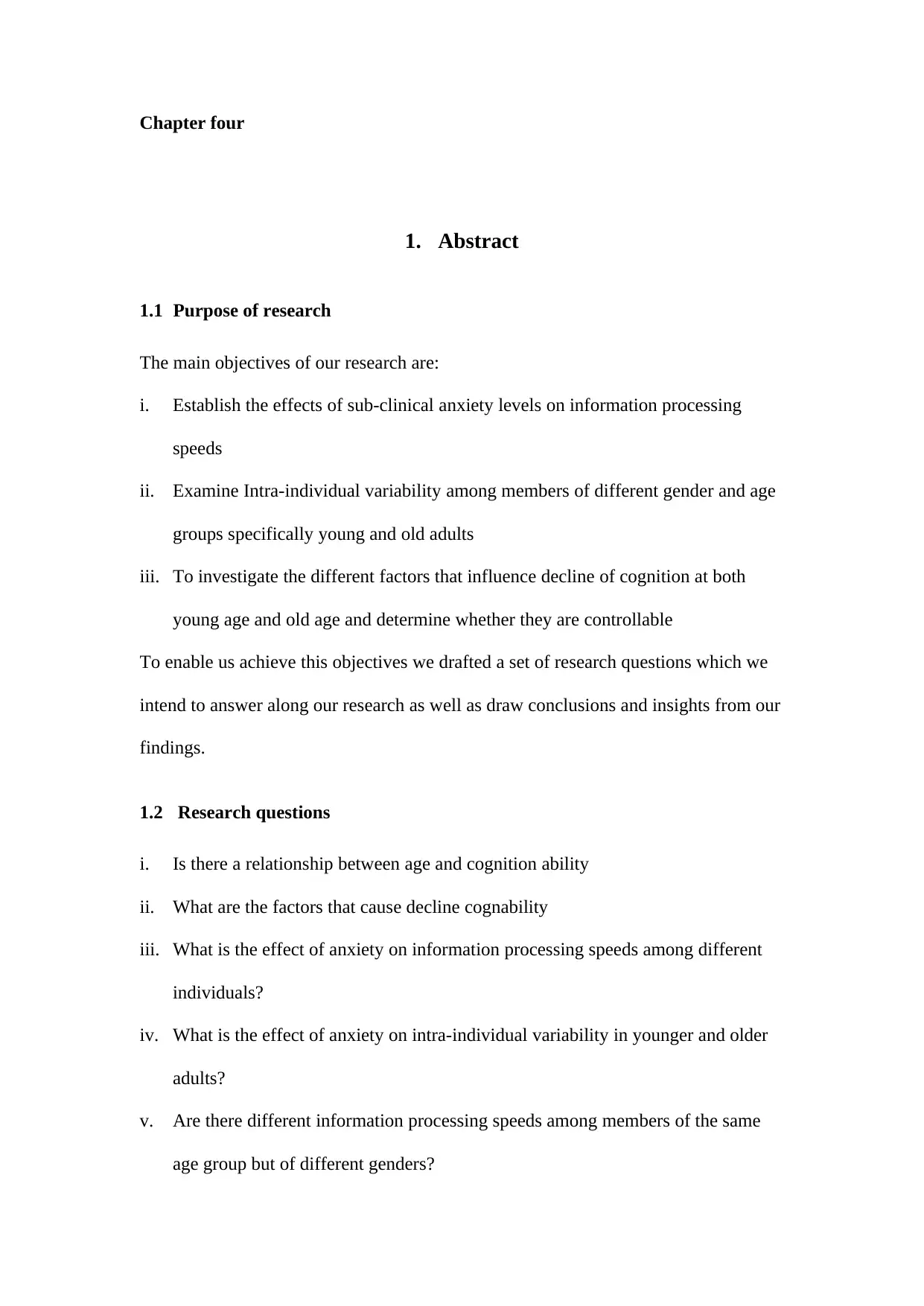
Chapter four
1. Abstract
1.1 Purpose of research
The main objectives of our research are:
i. Establish the effects of sub-clinical anxiety levels on information processing
speeds
ii. Examine Intra-individual variability among members of different gender and age
groups specifically young and old adults
iii. To investigate the different factors that influence decline of cognition at both
young age and old age and determine whether they are controllable
To enable us achieve this objectives we drafted a set of research questions which we
intend to answer along our research as well as draw conclusions and insights from our
findings.
1.2 Research questions
i. Is there a relationship between age and cognition ability
ii. What are the factors that cause decline cognability
iii. What is the effect of anxiety on information processing speeds among different
individuals?
iv. What is the effect of anxiety on intra-individual variability in younger and older
adults?
v. Are there different information processing speeds among members of the same
age group but of different genders?
1. Abstract
1.1 Purpose of research
The main objectives of our research are:
i. Establish the effects of sub-clinical anxiety levels on information processing
speeds
ii. Examine Intra-individual variability among members of different gender and age
groups specifically young and old adults
iii. To investigate the different factors that influence decline of cognition at both
young age and old age and determine whether they are controllable
To enable us achieve this objectives we drafted a set of research questions which we
intend to answer along our research as well as draw conclusions and insights from our
findings.
1.2 Research questions
i. Is there a relationship between age and cognition ability
ii. What are the factors that cause decline cognability
iii. What is the effect of anxiety on information processing speeds among different
individuals?
iv. What is the effect of anxiety on intra-individual variability in younger and older
adults?
v. Are there different information processing speeds among members of the same
age group but of different genders?
Secure Best Marks with AI Grader
Need help grading? Try our AI Grader for instant feedback on your assignments.
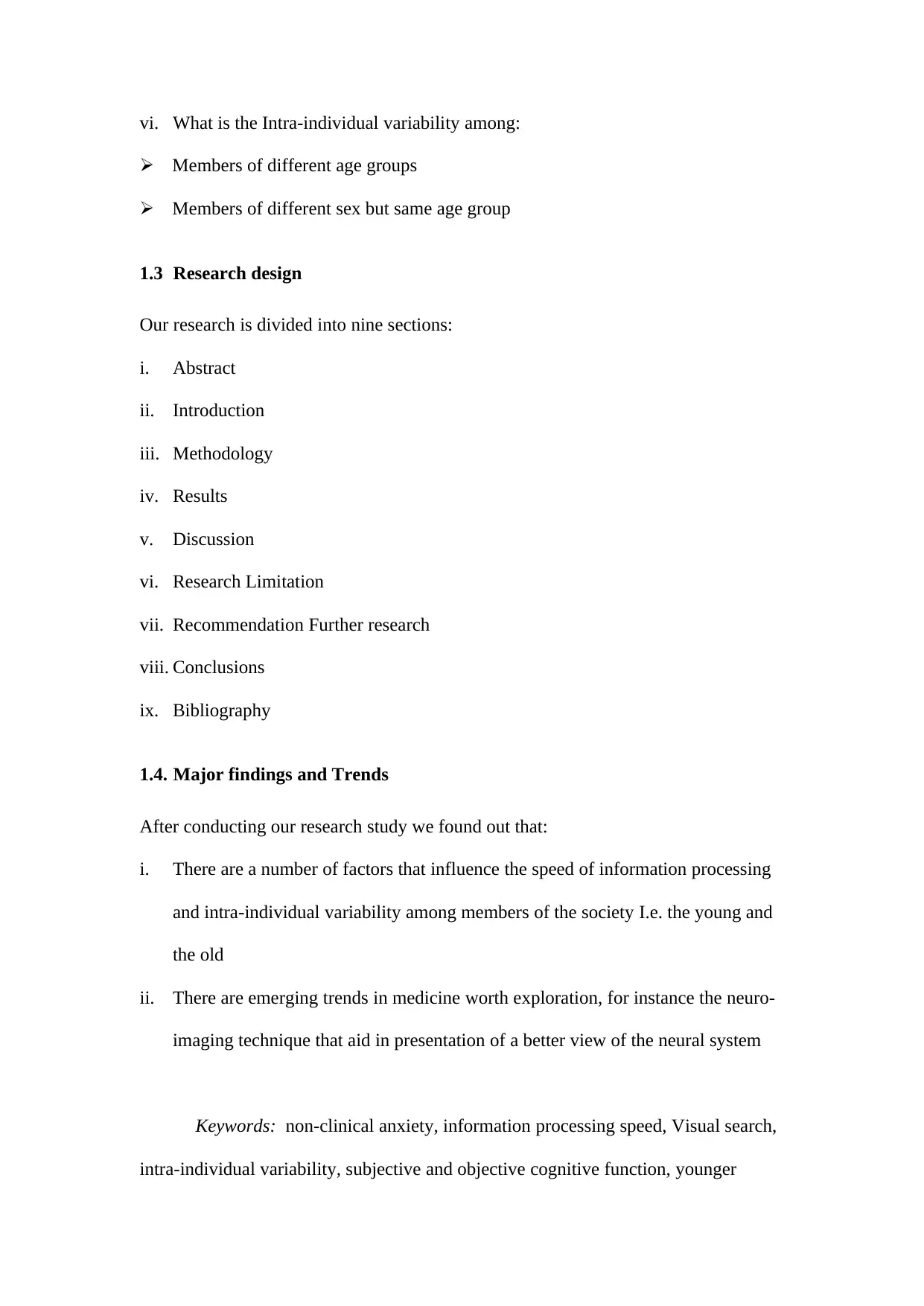
vi. What is the Intra-individual variability among:
Members of different age groups
Members of different sex but same age group
1.3 Research design
Our research is divided into nine sections:
i. Abstract
ii. Introduction
iii. Methodology
iv. Results
v. Discussion
vi. Research Limitation
vii. Recommendation Further research
viii. Conclusions
ix. Bibliography
1.4. Major findings and Trends
After conducting our research study we found out that:
i. There are a number of factors that influence the speed of information processing
and intra-individual variability among members of the society I.e. the young and
the old
ii. There are emerging trends in medicine worth exploration, for instance the neuro-
imaging technique that aid in presentation of a better view of the neural system
Keywords: non-clinical anxiety, information processing speed, Visual search,
intra-individual variability, subjective and objective cognitive function, younger
Members of different age groups
Members of different sex but same age group
1.3 Research design
Our research is divided into nine sections:
i. Abstract
ii. Introduction
iii. Methodology
iv. Results
v. Discussion
vi. Research Limitation
vii. Recommendation Further research
viii. Conclusions
ix. Bibliography
1.4. Major findings and Trends
After conducting our research study we found out that:
i. There are a number of factors that influence the speed of information processing
and intra-individual variability among members of the society I.e. the young and
the old
ii. There are emerging trends in medicine worth exploration, for instance the neuro-
imaging technique that aid in presentation of a better view of the neural system
Keywords: non-clinical anxiety, information processing speed, Visual search,
intra-individual variability, subjective and objective cognitive function, younger
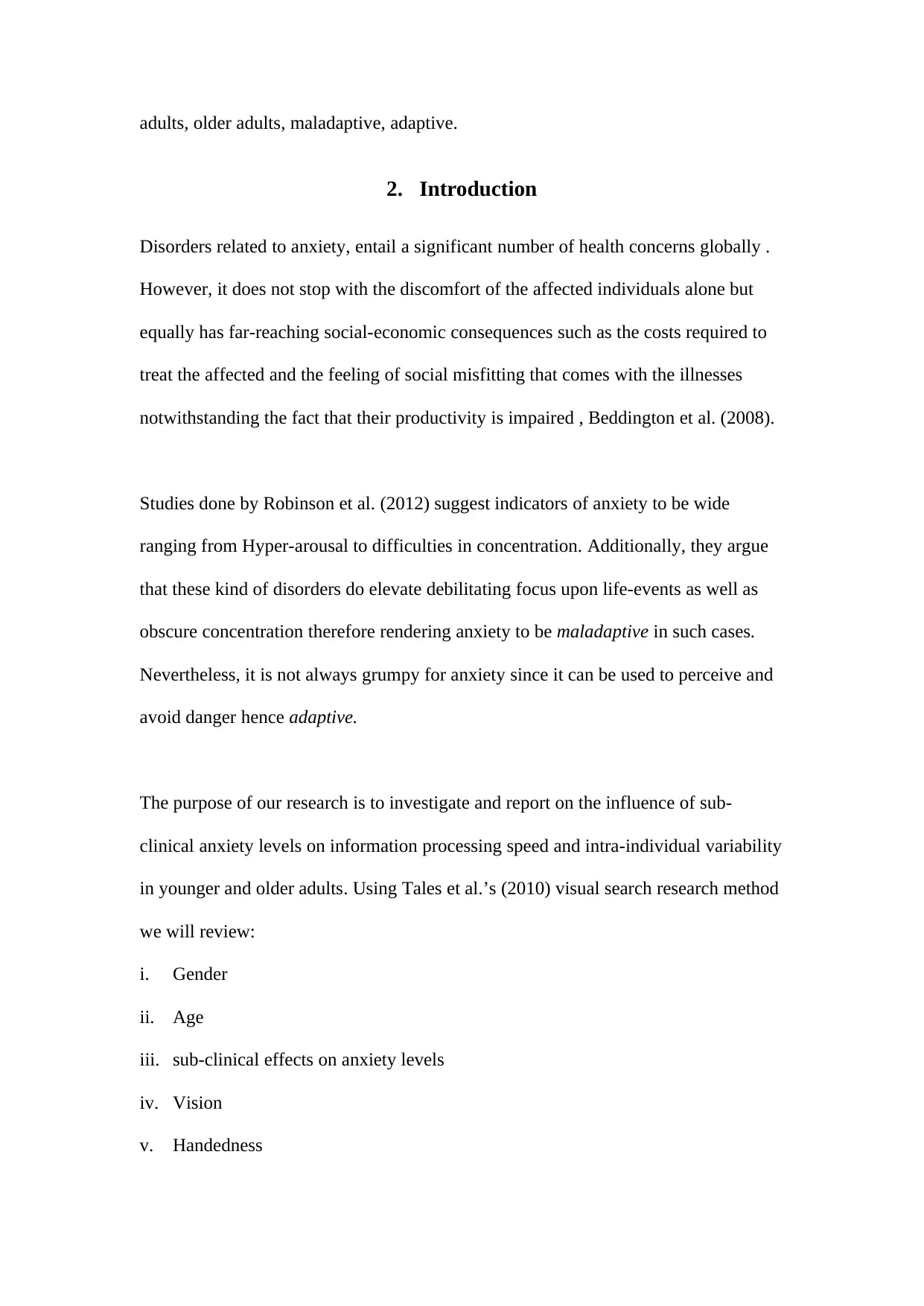
adults, older adults, maladaptive, adaptive.
2. Introduction
Disorders related to anxiety, entail a significant number of health concerns globally .
However, it does not stop with the discomfort of the affected individuals alone but
equally has far-reaching social-economic consequences such as the costs required to
treat the affected and the feeling of social misfitting that comes with the illnesses
notwithstanding the fact that their productivity is impaired , Beddington et al. (2008).
Studies done by Robinson et al. (2012) suggest indicators of anxiety to be wide
ranging from Hyper-arousal to difficulties in concentration. Additionally, they argue
that these kind of disorders do elevate debilitating focus upon life-events as well as
obscure concentration therefore rendering anxiety to be maladaptive in such cases.
Nevertheless, it is not always grumpy for anxiety since it can be used to perceive and
avoid danger hence adaptive.
The purpose of our research is to investigate and report on the influence of sub-
clinical anxiety levels on information processing speed and intra-individual variability
in younger and older adults. Using Tales et al.’s (2010) visual search research method
we will review:
i. Gender
ii. Age
iii. sub-clinical effects on anxiety levels
iv. Vision
v. Handedness
2. Introduction
Disorders related to anxiety, entail a significant number of health concerns globally .
However, it does not stop with the discomfort of the affected individuals alone but
equally has far-reaching social-economic consequences such as the costs required to
treat the affected and the feeling of social misfitting that comes with the illnesses
notwithstanding the fact that their productivity is impaired , Beddington et al. (2008).
Studies done by Robinson et al. (2012) suggest indicators of anxiety to be wide
ranging from Hyper-arousal to difficulties in concentration. Additionally, they argue
that these kind of disorders do elevate debilitating focus upon life-events as well as
obscure concentration therefore rendering anxiety to be maladaptive in such cases.
Nevertheless, it is not always grumpy for anxiety since it can be used to perceive and
avoid danger hence adaptive.
The purpose of our research is to investigate and report on the influence of sub-
clinical anxiety levels on information processing speed and intra-individual variability
in younger and older adults. Using Tales et al.’s (2010) visual search research method
we will review:
i. Gender
ii. Age
iii. sub-clinical effects on anxiety levels
iv. Vision
v. Handedness
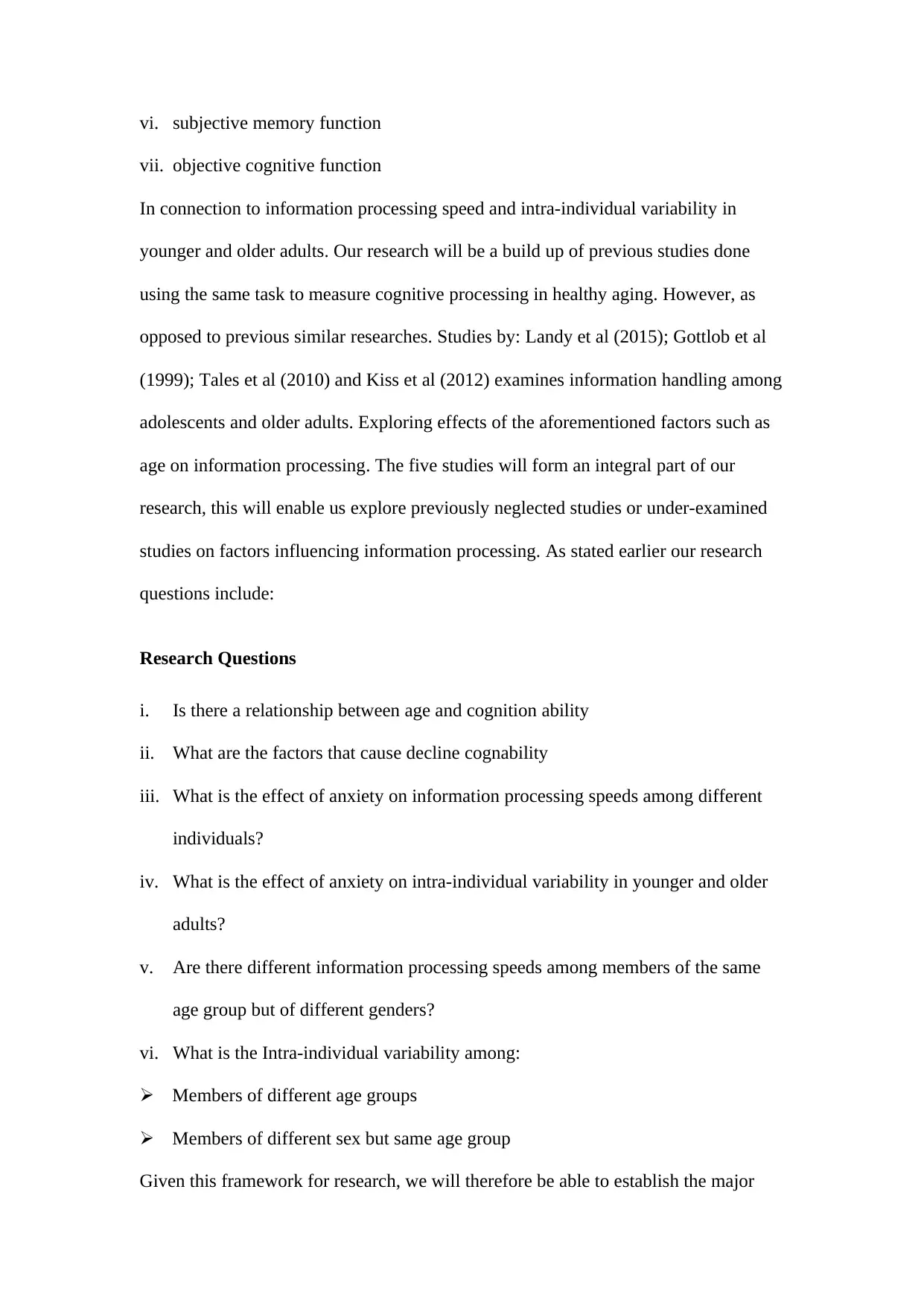
vi. subjective memory function
vii. objective cognitive function
In connection to information processing speed and intra-individual variability in
younger and older adults. Our research will be a build up of previous studies done
using the same task to measure cognitive processing in healthy aging. However, as
opposed to previous similar researches. Studies by: Landy et al (2015); Gottlob et al
(1999); Tales et al (2010) and Kiss et al (2012) examines information handling among
adolescents and older adults. Exploring effects of the aforementioned factors such as
age on information processing. The five studies will form an integral part of our
research, this will enable us explore previously neglected studies or under-examined
studies on factors influencing information processing. As stated earlier our research
questions include:
Research Questions
i. Is there a relationship between age and cognition ability
ii. What are the factors that cause decline cognability
iii. What is the effect of anxiety on information processing speeds among different
individuals?
iv. What is the effect of anxiety on intra-individual variability in younger and older
adults?
v. Are there different information processing speeds among members of the same
age group but of different genders?
vi. What is the Intra-individual variability among:
Members of different age groups
Members of different sex but same age group
Given this framework for research, we will therefore be able to establish the major
vii. objective cognitive function
In connection to information processing speed and intra-individual variability in
younger and older adults. Our research will be a build up of previous studies done
using the same task to measure cognitive processing in healthy aging. However, as
opposed to previous similar researches. Studies by: Landy et al (2015); Gottlob et al
(1999); Tales et al (2010) and Kiss et al (2012) examines information handling among
adolescents and older adults. Exploring effects of the aforementioned factors such as
age on information processing. The five studies will form an integral part of our
research, this will enable us explore previously neglected studies or under-examined
studies on factors influencing information processing. As stated earlier our research
questions include:
Research Questions
i. Is there a relationship between age and cognition ability
ii. What are the factors that cause decline cognability
iii. What is the effect of anxiety on information processing speeds among different
individuals?
iv. What is the effect of anxiety on intra-individual variability in younger and older
adults?
v. Are there different information processing speeds among members of the same
age group but of different genders?
vi. What is the Intra-individual variability among:
Members of different age groups
Members of different sex but same age group
Given this framework for research, we will therefore be able to establish the major
Secure Best Marks with AI Grader
Need help grading? Try our AI Grader for instant feedback on your assignments.
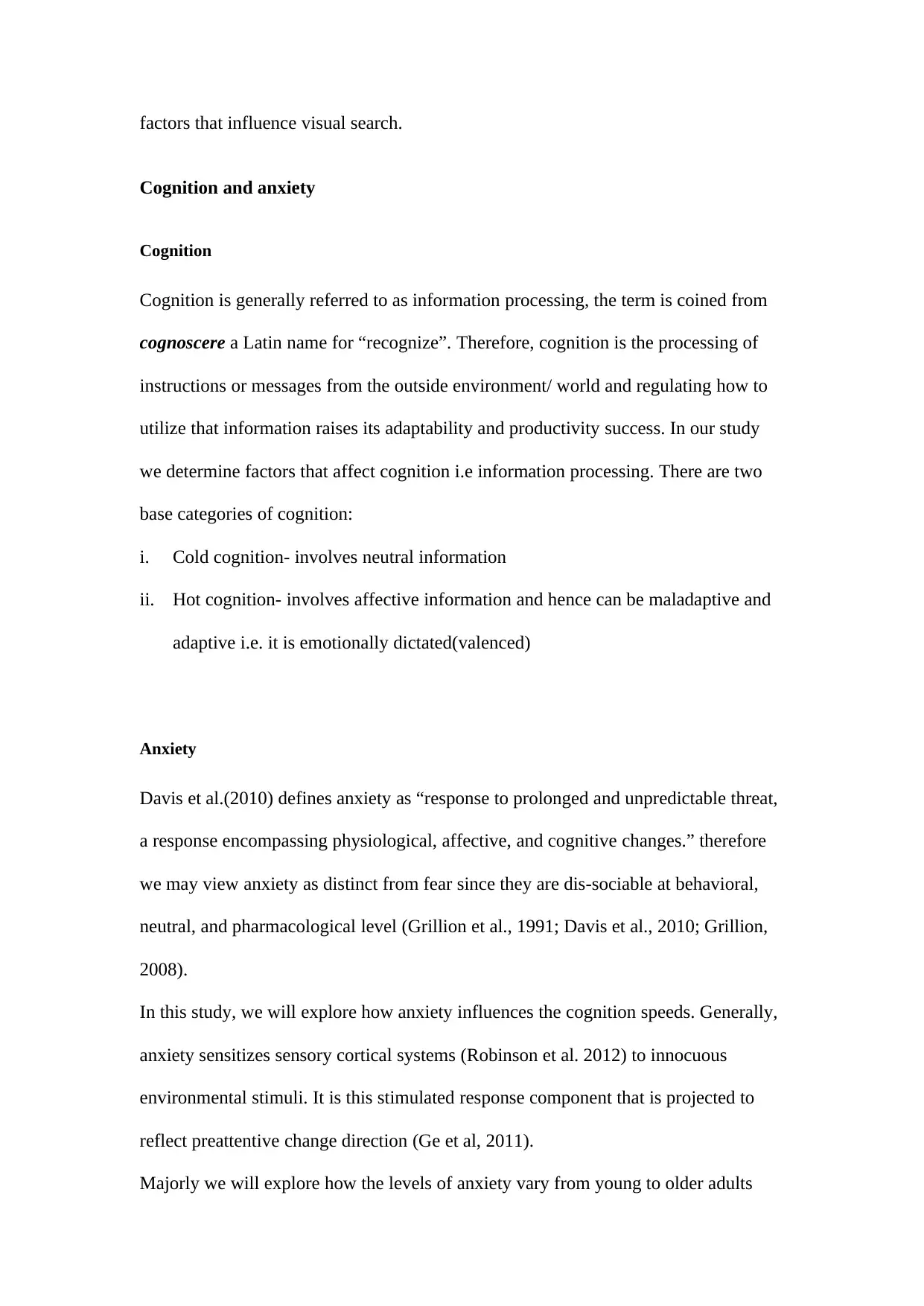
factors that influence visual search.
Cognition and anxiety
Cognition
Cognition is generally referred to as information processing, the term is coined from
cognoscere a Latin name for “recognize”. Therefore, cognition is the processing of
instructions or messages from the outside environment/ world and regulating how to
utilize that information raises its adaptability and productivity success. In our study
we determine factors that affect cognition i.e information processing. There are two
base categories of cognition:
i. Cold cognition- involves neutral information
ii. Hot cognition- involves affective information and hence can be maladaptive and
adaptive i.e. it is emotionally dictated(valenced)
Anxiety
Davis et al.(2010) defines anxiety as “response to prolonged and unpredictable threat,
a response encompassing physiological, affective, and cognitive changes.” therefore
we may view anxiety as distinct from fear since they are dis-sociable at behavioral,
neutral, and pharmacological level (Grillion et al., 1991; Davis et al., 2010; Grillion,
2008).
In this study, we will explore how anxiety influences the cognition speeds. Generally,
anxiety sensitizes sensory cortical systems (Robinson et al. 2012) to innocuous
environmental stimuli. It is this stimulated response component that is projected to
reflect preattentive change direction (Ge et al, 2011).
Majorly we will explore how the levels of anxiety vary from young to older adults
Cognition and anxiety
Cognition
Cognition is generally referred to as information processing, the term is coined from
cognoscere a Latin name for “recognize”. Therefore, cognition is the processing of
instructions or messages from the outside environment/ world and regulating how to
utilize that information raises its adaptability and productivity success. In our study
we determine factors that affect cognition i.e information processing. There are two
base categories of cognition:
i. Cold cognition- involves neutral information
ii. Hot cognition- involves affective information and hence can be maladaptive and
adaptive i.e. it is emotionally dictated(valenced)
Anxiety
Davis et al.(2010) defines anxiety as “response to prolonged and unpredictable threat,
a response encompassing physiological, affective, and cognitive changes.” therefore
we may view anxiety as distinct from fear since they are dis-sociable at behavioral,
neutral, and pharmacological level (Grillion et al., 1991; Davis et al., 2010; Grillion,
2008).
In this study, we will explore how anxiety influences the cognition speeds. Generally,
anxiety sensitizes sensory cortical systems (Robinson et al. 2012) to innocuous
environmental stimuli. It is this stimulated response component that is projected to
reflect preattentive change direction (Ge et al, 2011).
Majorly we will explore how the levels of anxiety vary from young to older adults

and establish how this variability affects cognition in the subgroups of interest.
Sensory perceptual processes
This are the basis of all cognitive processes. Therefore, Sensory perceptual processes
are the immediate processing and perception of environmental stimuli.
Information processing speed
Refers to the ease with which the cognitive brain reacts to external stimuli.
Generally,Information processing speed is measured as part of the diagnosis of
dementia and Mild Cognitive Impairment (MCI). In normal aging, the brain functions
slow down while intelligence measures stabilize, and ability for recall decreases
significantly. Research evidence indicates that information processing speed can vary
significantly with respect to methodological factors such as the task used; thus the
areas of the brain recruited for performance and response demands (Rodrigues &
Pandeirada, 2014; Valeriani et al., 2003), person-related factors such as sex
(Commmodari & Guanera, 2013), education (Tales & Basoudan, 2016), and possibly
genetic factors (Luo et al., 2017). Interactions between these factors can result in
significantly different impacts on processing speeds, depending on specific brain
areas required for the performance of tasks (Tales et al., 2010; Tales & Basoudan,
2016). Previous researches suggest an existence of an association between
information processing speed and the functional integrity of both cognitive and of
neuro-anatomical (Anstey et al., 2007; Haynes et al., 2017; Kennedy et al., 2013;
Lövdén, Shing & Lindberger, 2007; Voelker et al., 2017). Additionally studies on
Neuro-anatomical have identified age-related differences in the inter-hemispheric data
transfer rates and activation, as well as differences in white matter integrity; older
adults demonstrate greater transfer rates than younger ones, possibly as a
Sensory perceptual processes
This are the basis of all cognitive processes. Therefore, Sensory perceptual processes
are the immediate processing and perception of environmental stimuli.
Information processing speed
Refers to the ease with which the cognitive brain reacts to external stimuli.
Generally,Information processing speed is measured as part of the diagnosis of
dementia and Mild Cognitive Impairment (MCI). In normal aging, the brain functions
slow down while intelligence measures stabilize, and ability for recall decreases
significantly. Research evidence indicates that information processing speed can vary
significantly with respect to methodological factors such as the task used; thus the
areas of the brain recruited for performance and response demands (Rodrigues &
Pandeirada, 2014; Valeriani et al., 2003), person-related factors such as sex
(Commmodari & Guanera, 2013), education (Tales & Basoudan, 2016), and possibly
genetic factors (Luo et al., 2017). Interactions between these factors can result in
significantly different impacts on processing speeds, depending on specific brain
areas required for the performance of tasks (Tales et al., 2010; Tales & Basoudan,
2016). Previous researches suggest an existence of an association between
information processing speed and the functional integrity of both cognitive and of
neuro-anatomical (Anstey et al., 2007; Haynes et al., 2017; Kennedy et al., 2013;
Lövdén, Shing & Lindberger, 2007; Voelker et al., 2017). Additionally studies on
Neuro-anatomical have identified age-related differences in the inter-hemispheric data
transfer rates and activation, as well as differences in white matter integrity; older
adults demonstrate greater transfer rates than younger ones, possibly as a

compensatory strategy to overcome ageing-related cognitive declines (Anstey et al.,
2007; Haynes et al., 2017). These differences are identifiable using reaction time tasks
as fundamental measures of both inter-hemispheric transfer and cognitive changes due
to ageing (Antsey et al., 2007).
Subjective Cognitive Function
An important factor though rarely has it been considered for the investigation
of information processing speed in ageing and ageing-related disease is the subjective
cognitive function. Although most studies examining information processing speed in
ageing measure and factor in the potential influence of objectively measured status of
cognitive function, it is rare for research results to consider how subjective feelings or
assessment of the cognitive function may influence information processing speed.
Objective measures of poor general cognition are often found to be related to slower
information processing speeds, compared to intact cognition in older adults (Tales &
Basoudan, 2016). It is possible that subjectively poor cognition, by itself and in
combination with anxiety, may also affect information processing speed (either
through similar or different mechanisms, yet to be fully identified).
If this is the case, then both clinical and research findings would need to be
interpreted with respect to this caveat also. As mentioned above, a further aim of this
study is to determine whether in older adults, either objectively-measured or
subjectively-experienced cognitive function influences information processing speed.
Finally, the potential influence of sex (male/female) and educational level upon
information processing speed will also be investigated.
2007; Haynes et al., 2017). These differences are identifiable using reaction time tasks
as fundamental measures of both inter-hemispheric transfer and cognitive changes due
to ageing (Antsey et al., 2007).
Subjective Cognitive Function
An important factor though rarely has it been considered for the investigation
of information processing speed in ageing and ageing-related disease is the subjective
cognitive function. Although most studies examining information processing speed in
ageing measure and factor in the potential influence of objectively measured status of
cognitive function, it is rare for research results to consider how subjective feelings or
assessment of the cognitive function may influence information processing speed.
Objective measures of poor general cognition are often found to be related to slower
information processing speeds, compared to intact cognition in older adults (Tales &
Basoudan, 2016). It is possible that subjectively poor cognition, by itself and in
combination with anxiety, may also affect information processing speed (either
through similar or different mechanisms, yet to be fully identified).
If this is the case, then both clinical and research findings would need to be
interpreted with respect to this caveat also. As mentioned above, a further aim of this
study is to determine whether in older adults, either objectively-measured or
subjectively-experienced cognitive function influences information processing speed.
Finally, the potential influence of sex (male/female) and educational level upon
information processing speed will also be investigated.
Paraphrase This Document
Need a fresh take? Get an instant paraphrase of this document with our AI Paraphraser
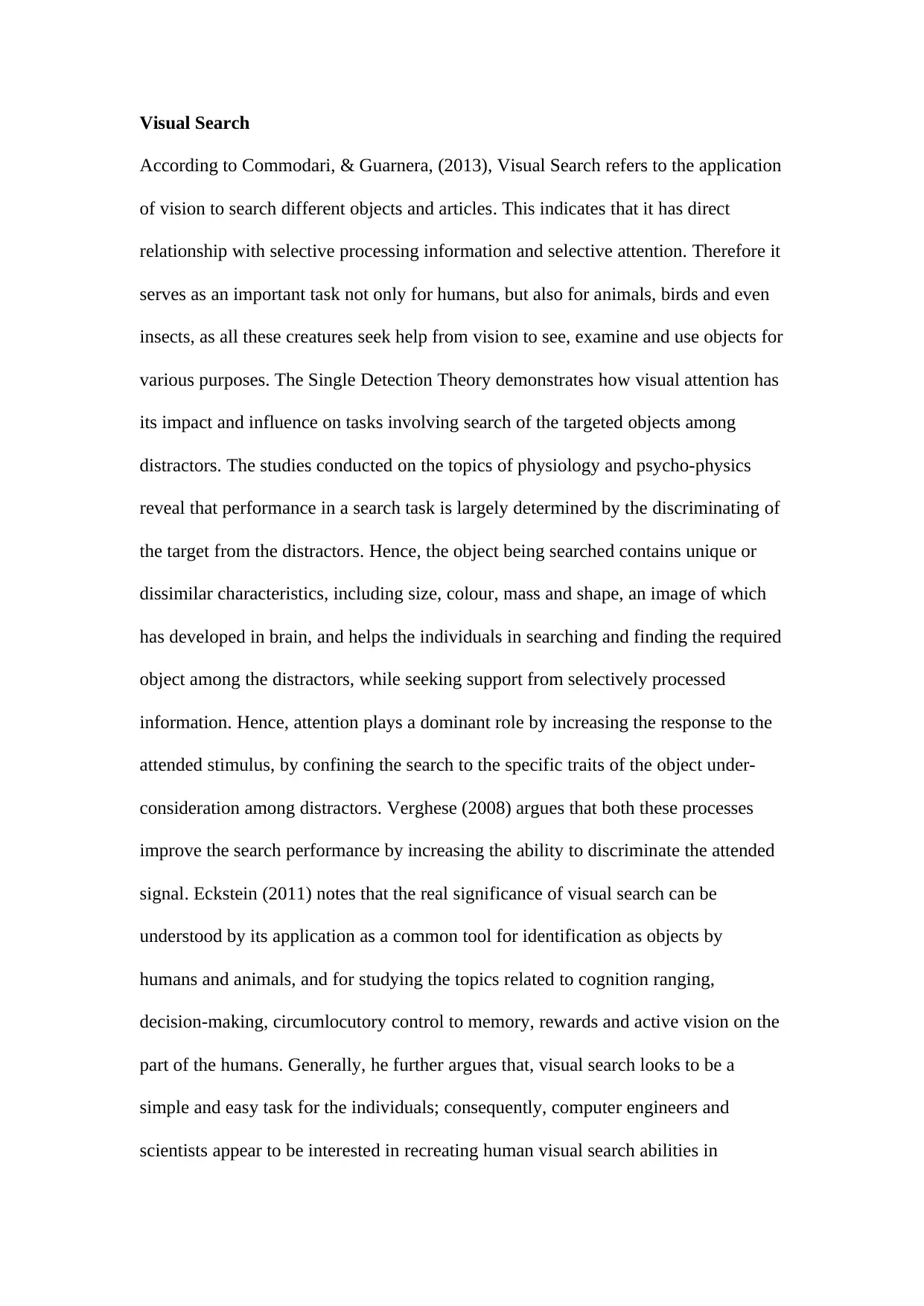
Visual Search
According to Commodari, & Guarnera, (2013), Visual Search refers to the application
of vision to search different objects and articles. This indicates that it has direct
relationship with selective processing information and selective attention. Therefore it
serves as an important task not only for humans, but also for animals, birds and even
insects, as all these creatures seek help from vision to see, examine and use objects for
various purposes. The Single Detection Theory demonstrates how visual attention has
its impact and influence on tasks involving search of the targeted objects among
distractors. The studies conducted on the topics of physiology and psycho-physics
reveal that performance in a search task is largely determined by the discriminating of
the target from the distractors. Hence, the object being searched contains unique or
dissimilar characteristics, including size, colour, mass and shape, an image of which
has developed in brain, and helps the individuals in searching and finding the required
object among the distractors, while seeking support from selectively processed
information. Hence, attention plays a dominant role by increasing the response to the
attended stimulus, by confining the search to the specific traits of the object under-
consideration among distractors. Verghese (2008) argues that both these processes
improve the search performance by increasing the ability to discriminate the attended
signal. Eckstein (2011) notes that the real significance of visual search can be
understood by its application as a common tool for identification as objects by
humans and animals, and for studying the topics related to cognition ranging,
decision-making, circumlocutory control to memory, rewards and active vision on the
part of the humans. Generally, he further argues that, visual search looks to be a
simple and easy task for the individuals; consequently, computer engineers and
scientists appear to be interested in recreating human visual search abilities in
According to Commodari, & Guarnera, (2013), Visual Search refers to the application
of vision to search different objects and articles. This indicates that it has direct
relationship with selective processing information and selective attention. Therefore it
serves as an important task not only for humans, but also for animals, birds and even
insects, as all these creatures seek help from vision to see, examine and use objects for
various purposes. The Single Detection Theory demonstrates how visual attention has
its impact and influence on tasks involving search of the targeted objects among
distractors. The studies conducted on the topics of physiology and psycho-physics
reveal that performance in a search task is largely determined by the discriminating of
the target from the distractors. Hence, the object being searched contains unique or
dissimilar characteristics, including size, colour, mass and shape, an image of which
has developed in brain, and helps the individuals in searching and finding the required
object among the distractors, while seeking support from selectively processed
information. Hence, attention plays a dominant role by increasing the response to the
attended stimulus, by confining the search to the specific traits of the object under-
consideration among distractors. Verghese (2008) argues that both these processes
improve the search performance by increasing the ability to discriminate the attended
signal. Eckstein (2011) notes that the real significance of visual search can be
understood by its application as a common tool for identification as objects by
humans and animals, and for studying the topics related to cognition ranging,
decision-making, circumlocutory control to memory, rewards and active vision on the
part of the humans. Generally, he further argues that, visual search looks to be a
simple and easy task for the individuals; consequently, computer engineers and
scientists appear to be interested in recreating human visual search abilities in
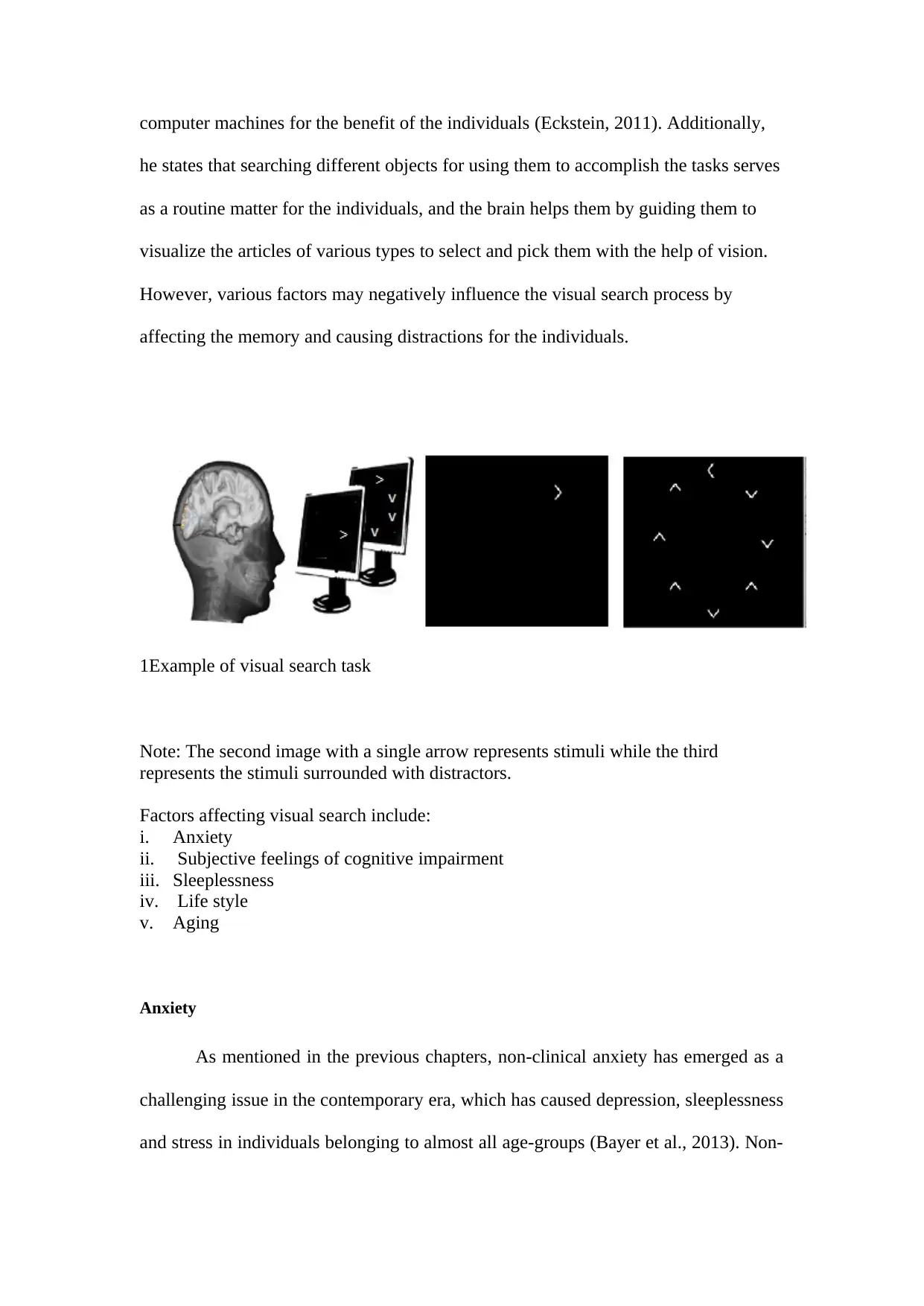
computer machines for the benefit of the individuals (Eckstein, 2011). Additionally,
he states that searching different objects for using them to accomplish the tasks serves
as a routine matter for the individuals, and the brain helps them by guiding them to
visualize the articles of various types to select and pick them with the help of vision.
However, various factors may negatively influence the visual search process by
affecting the memory and causing distractions for the individuals.
1Example of visual search task
Note: The second image with a single arrow represents stimuli while the third
represents the stimuli surrounded with distractors.
Factors affecting visual search include:
i. Anxiety
ii. Subjective feelings of cognitive impairment
iii. Sleeplessness
iv. Life style
v. Aging
Anxiety
As mentioned in the previous chapters, non-clinical anxiety has emerged as a
challenging issue in the contemporary era, which has caused depression, sleeplessness
and stress in individuals belonging to almost all age-groups (Bayer et al., 2013). Non-
he states that searching different objects for using them to accomplish the tasks serves
as a routine matter for the individuals, and the brain helps them by guiding them to
visualize the articles of various types to select and pick them with the help of vision.
However, various factors may negatively influence the visual search process by
affecting the memory and causing distractions for the individuals.
1Example of visual search task
Note: The second image with a single arrow represents stimuli while the third
represents the stimuli surrounded with distractors.
Factors affecting visual search include:
i. Anxiety
ii. Subjective feelings of cognitive impairment
iii. Sleeplessness
iv. Life style
v. Aging
Anxiety
As mentioned in the previous chapters, non-clinical anxiety has emerged as a
challenging issue in the contemporary era, which has caused depression, sleeplessness
and stress in individuals belonging to almost all age-groups (Bayer et al., 2013). Non-
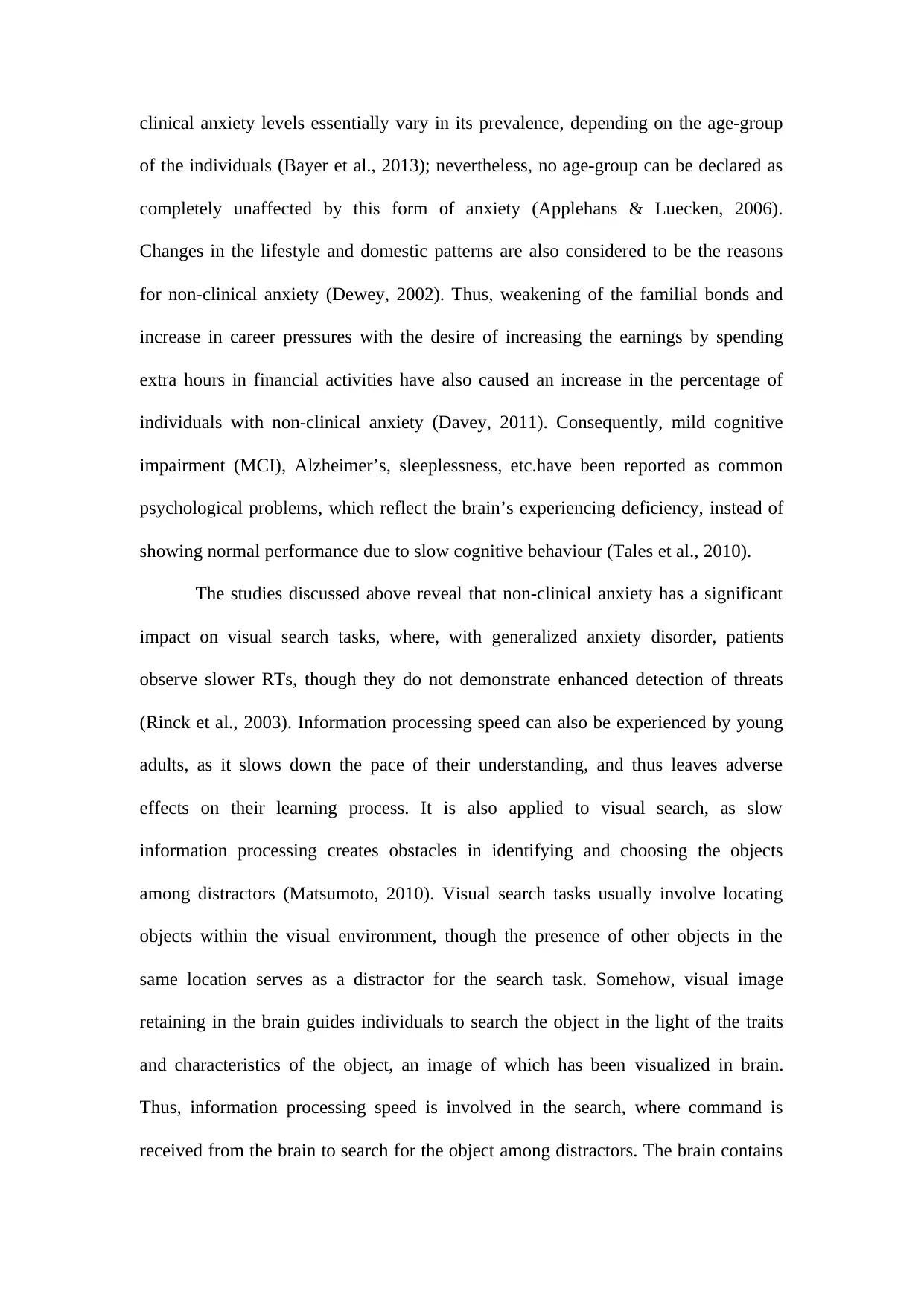
clinical anxiety levels essentially vary in its prevalence, depending on the age-group
of the individuals (Bayer et al., 2013); nevertheless, no age-group can be declared as
completely unaffected by this form of anxiety (Applehans & Luecken, 2006).
Changes in the lifestyle and domestic patterns are also considered to be the reasons
for non-clinical anxiety (Dewey, 2002). Thus, weakening of the familial bonds and
increase in career pressures with the desire of increasing the earnings by spending
extra hours in financial activities have also caused an increase in the percentage of
individuals with non-clinical anxiety (Davey, 2011). Consequently, mild cognitive
impairment (MCI), Alzheimer’s, sleeplessness, etc.have been reported as common
psychological problems, which reflect the brain’s experiencing deficiency, instead of
showing normal performance due to slow cognitive behaviour (Tales et al., 2010).
The studies discussed above reveal that non-clinical anxiety has a significant
impact on visual search tasks, where, with generalized anxiety disorder, patients
observe slower RTs, though they do not demonstrate enhanced detection of threats
(Rinck et al., 2003). Information processing speed can also be experienced by young
adults, as it slows down the pace of their understanding, and thus leaves adverse
effects on their learning process. It is also applied to visual search, as slow
information processing creates obstacles in identifying and choosing the objects
among distractors (Matsumoto, 2010). Visual search tasks usually involve locating
objects within the visual environment, though the presence of other objects in the
same location serves as a distractor for the search task. Somehow, visual image
retaining in the brain guides individuals to search the object in the light of the traits
and characteristics of the object, an image of which has been visualized in brain.
Thus, information processing speed is involved in the search, where command is
received from the brain to search for the object among distractors. The brain contains
of the individuals (Bayer et al., 2013); nevertheless, no age-group can be declared as
completely unaffected by this form of anxiety (Applehans & Luecken, 2006).
Changes in the lifestyle and domestic patterns are also considered to be the reasons
for non-clinical anxiety (Dewey, 2002). Thus, weakening of the familial bonds and
increase in career pressures with the desire of increasing the earnings by spending
extra hours in financial activities have also caused an increase in the percentage of
individuals with non-clinical anxiety (Davey, 2011). Consequently, mild cognitive
impairment (MCI), Alzheimer’s, sleeplessness, etc.have been reported as common
psychological problems, which reflect the brain’s experiencing deficiency, instead of
showing normal performance due to slow cognitive behaviour (Tales et al., 2010).
The studies discussed above reveal that non-clinical anxiety has a significant
impact on visual search tasks, where, with generalized anxiety disorder, patients
observe slower RTs, though they do not demonstrate enhanced detection of threats
(Rinck et al., 2003). Information processing speed can also be experienced by young
adults, as it slows down the pace of their understanding, and thus leaves adverse
effects on their learning process. It is also applied to visual search, as slow
information processing creates obstacles in identifying and choosing the objects
among distractors (Matsumoto, 2010). Visual search tasks usually involve locating
objects within the visual environment, though the presence of other objects in the
same location serves as a distractor for the search task. Somehow, visual image
retaining in the brain guides individuals to search the object in the light of the traits
and characteristics of the object, an image of which has been visualized in brain.
Thus, information processing speed is involved in the search, where command is
received from the brain to search for the object among distractors. The brain contains
Secure Best Marks with AI Grader
Need help grading? Try our AI Grader for instant feedback on your assignments.
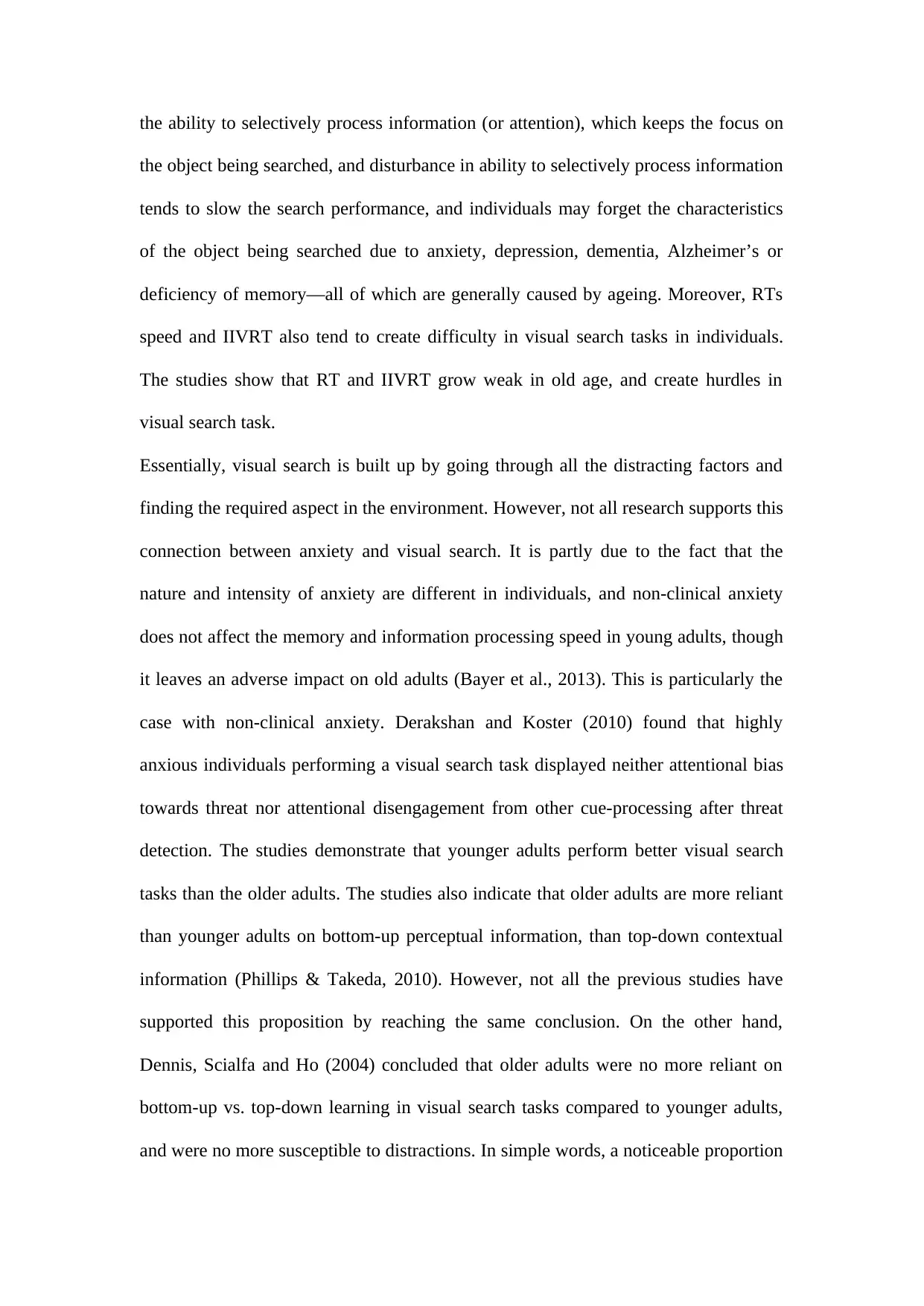
the ability to selectively process information (or attention), which keeps the focus on
the object being searched, and disturbance in ability to selectively process information
tends to slow the search performance, and individuals may forget the characteristics
of the object being searched due to anxiety, depression, dementia, Alzheimer’s or
deficiency of memory—all of which are generally caused by ageing. Moreover, RTs
speed and IIVRT also tend to create difficulty in visual search tasks in individuals.
The studies show that RT and IIVRT grow weak in old age, and create hurdles in
visual search task.
Essentially, visual search is built up by going through all the distracting factors and
finding the required aspect in the environment. However, not all research supports this
connection between anxiety and visual search. It is partly due to the fact that the
nature and intensity of anxiety are different in individuals, and non-clinical anxiety
does not affect the memory and information processing speed in young adults, though
it leaves an adverse impact on old adults (Bayer et al., 2013). This is particularly the
case with non-clinical anxiety. Derakshan and Koster (2010) found that highly
anxious individuals performing a visual search task displayed neither attentional bias
towards threat nor attentional disengagement from other cue-processing after threat
detection. The studies demonstrate that younger adults perform better visual search
tasks than the older adults. The studies also indicate that older adults are more reliant
than younger adults on bottom-up perceptual information, than top-down contextual
information (Phillips & Takeda, 2010). However, not all the previous studies have
supported this proposition by reaching the same conclusion. On the other hand,
Dennis, Scialfa and Ho (2004) concluded that older adults were no more reliant on
bottom-up vs. top-down learning in visual search tasks compared to younger adults,
and were no more susceptible to distractions. In simple words, a noticeable proportion
the object being searched, and disturbance in ability to selectively process information
tends to slow the search performance, and individuals may forget the characteristics
of the object being searched due to anxiety, depression, dementia, Alzheimer’s or
deficiency of memory—all of which are generally caused by ageing. Moreover, RTs
speed and IIVRT also tend to create difficulty in visual search tasks in individuals.
The studies show that RT and IIVRT grow weak in old age, and create hurdles in
visual search task.
Essentially, visual search is built up by going through all the distracting factors and
finding the required aspect in the environment. However, not all research supports this
connection between anxiety and visual search. It is partly due to the fact that the
nature and intensity of anxiety are different in individuals, and non-clinical anxiety
does not affect the memory and information processing speed in young adults, though
it leaves an adverse impact on old adults (Bayer et al., 2013). This is particularly the
case with non-clinical anxiety. Derakshan and Koster (2010) found that highly
anxious individuals performing a visual search task displayed neither attentional bias
towards threat nor attentional disengagement from other cue-processing after threat
detection. The studies demonstrate that younger adults perform better visual search
tasks than the older adults. The studies also indicate that older adults are more reliant
than younger adults on bottom-up perceptual information, than top-down contextual
information (Phillips & Takeda, 2010). However, not all the previous studies have
supported this proposition by reaching the same conclusion. On the other hand,
Dennis, Scialfa and Ho (2004) concluded that older adults were no more reliant on
bottom-up vs. top-down learning in visual search tasks compared to younger adults,
and were no more susceptible to distractions. In simple words, a noticeable proportion
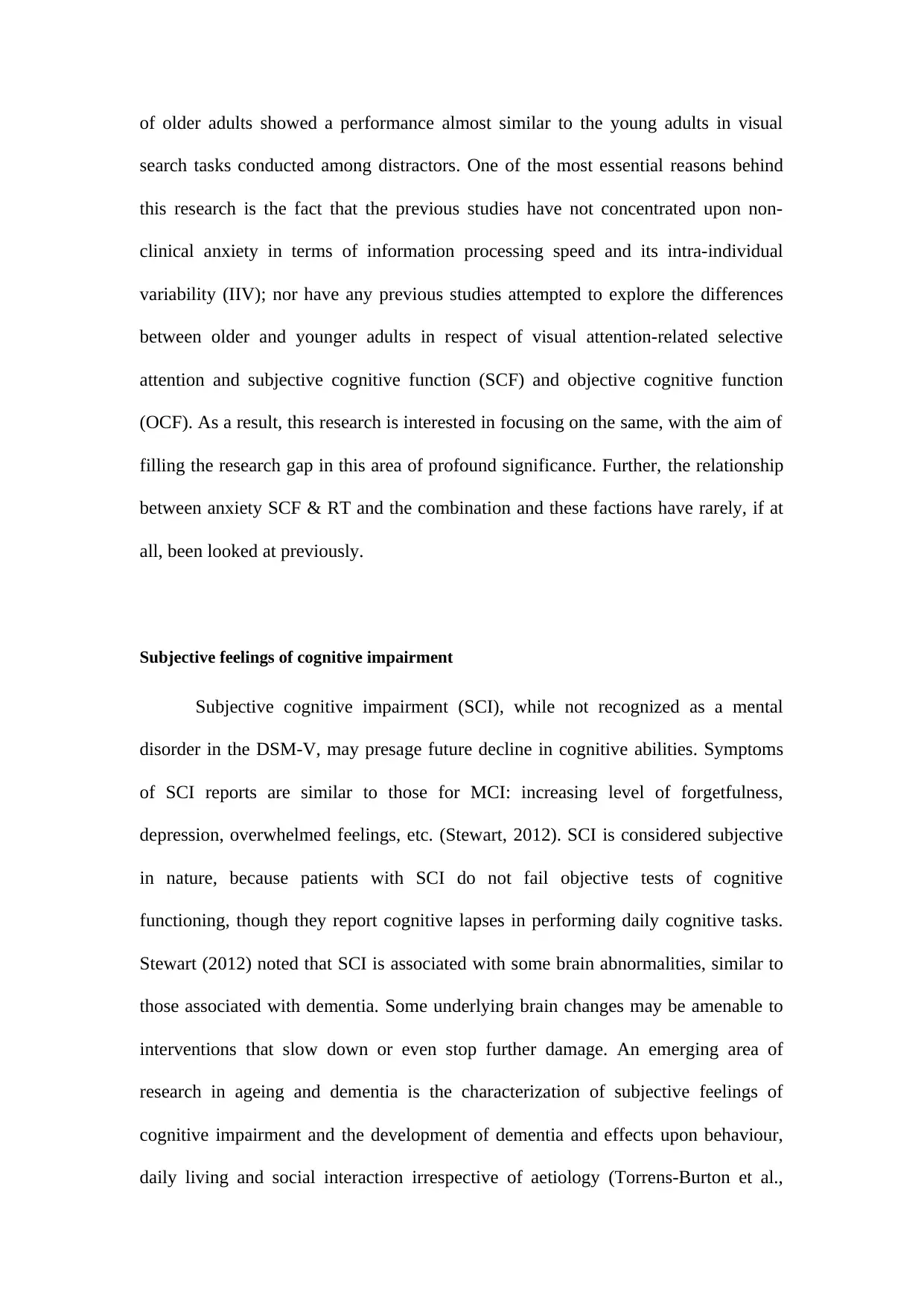
of older adults showed a performance almost similar to the young adults in visual
search tasks conducted among distractors. One of the most essential reasons behind
this research is the fact that the previous studies have not concentrated upon non-
clinical anxiety in terms of information processing speed and its intra-individual
variability (IIV); nor have any previous studies attempted to explore the differences
between older and younger adults in respect of visual attention-related selective
attention and subjective cognitive function (SCF) and objective cognitive function
(OCF). As a result, this research is interested in focusing on the same, with the aim of
filling the research gap in this area of profound significance. Further, the relationship
between anxiety SCF & RT and the combination and these factions have rarely, if at
all, been looked at previously.
Subjective feelings of cognitive impairment
Subjective cognitive impairment (SCI), while not recognized as a mental
disorder in the DSM-V, may presage future decline in cognitive abilities. Symptoms
of SCI reports are similar to those for MCI: increasing level of forgetfulness,
depression, overwhelmed feelings, etc. (Stewart, 2012). SCI is considered subjective
in nature, because patients with SCI do not fail objective tests of cognitive
functioning, though they report cognitive lapses in performing daily cognitive tasks.
Stewart (2012) noted that SCI is associated with some brain abnormalities, similar to
those associated with dementia. Some underlying brain changes may be amenable to
interventions that slow down or even stop further damage. An emerging area of
research in ageing and dementia is the characterization of subjective feelings of
cognitive impairment and the development of dementia and effects upon behaviour,
daily living and social interaction irrespective of aetiology (Torrens-Burton et al.,
search tasks conducted among distractors. One of the most essential reasons behind
this research is the fact that the previous studies have not concentrated upon non-
clinical anxiety in terms of information processing speed and its intra-individual
variability (IIV); nor have any previous studies attempted to explore the differences
between older and younger adults in respect of visual attention-related selective
attention and subjective cognitive function (SCF) and objective cognitive function
(OCF). As a result, this research is interested in focusing on the same, with the aim of
filling the research gap in this area of profound significance. Further, the relationship
between anxiety SCF & RT and the combination and these factions have rarely, if at
all, been looked at previously.
Subjective feelings of cognitive impairment
Subjective cognitive impairment (SCI), while not recognized as a mental
disorder in the DSM-V, may presage future decline in cognitive abilities. Symptoms
of SCI reports are similar to those for MCI: increasing level of forgetfulness,
depression, overwhelmed feelings, etc. (Stewart, 2012). SCI is considered subjective
in nature, because patients with SCI do not fail objective tests of cognitive
functioning, though they report cognitive lapses in performing daily cognitive tasks.
Stewart (2012) noted that SCI is associated with some brain abnormalities, similar to
those associated with dementia. Some underlying brain changes may be amenable to
interventions that slow down or even stop further damage. An emerging area of
research in ageing and dementia is the characterization of subjective feelings of
cognitive impairment and the development of dementia and effects upon behaviour,
daily living and social interaction irrespective of aetiology (Torrens-Burton et al.,
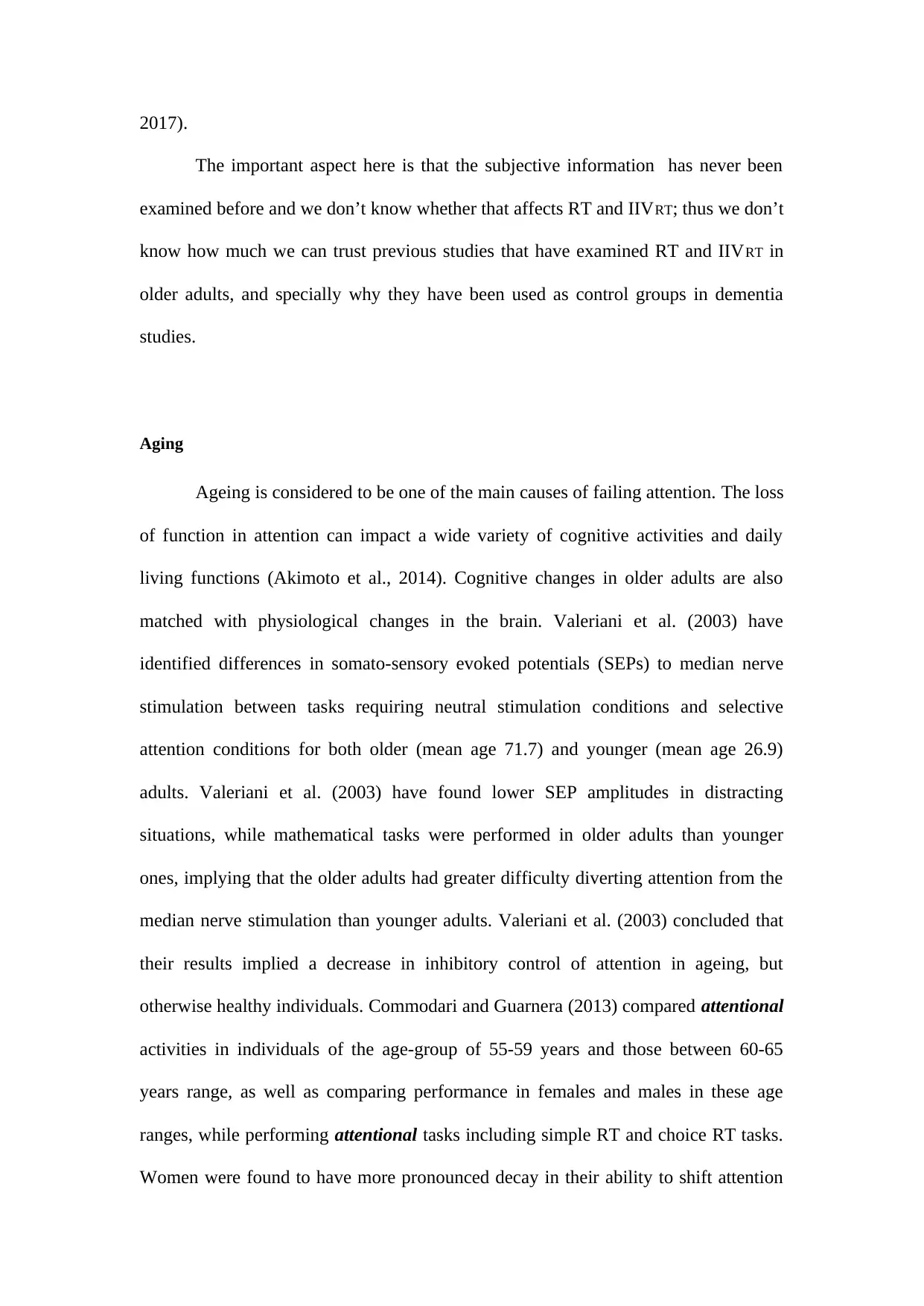
2017).
The important aspect here is that the subjective information has never been
examined before and we don’t know whether that affects RT and IIVRT; thus we don’t
know how much we can trust previous studies that have examined RT and IIVRT in
older adults, and specially why they have been used as control groups in dementia
studies.
Aging
Ageing is considered to be one of the main causes of failing attention. The loss
of function in attention can impact a wide variety of cognitive activities and daily
living functions (Akimoto et al., 2014). Cognitive changes in older adults are also
matched with physiological changes in the brain. Valeriani et al. (2003) have
identified differences in somato-sensory evoked potentials (SEPs) to median nerve
stimulation between tasks requiring neutral stimulation conditions and selective
attention conditions for both older (mean age 71.7) and younger (mean age 26.9)
adults. Valeriani et al. (2003) have found lower SEP amplitudes in distracting
situations, while mathematical tasks were performed in older adults than younger
ones, implying that the older adults had greater difficulty diverting attention from the
median nerve stimulation than younger adults. Valeriani et al. (2003) concluded that
their results implied a decrease in inhibitory control of attention in ageing, but
otherwise healthy individuals. Commodari and Guarnera (2013) compared attentional
activities in individuals of the age-group of 55-59 years and those between 60-65
years range, as well as comparing performance in females and males in these age
ranges, while performing attentional tasks including simple RT and choice RT tasks.
Women were found to have more pronounced decay in their ability to shift attention
The important aspect here is that the subjective information has never been
examined before and we don’t know whether that affects RT and IIVRT; thus we don’t
know how much we can trust previous studies that have examined RT and IIVRT in
older adults, and specially why they have been used as control groups in dementia
studies.
Aging
Ageing is considered to be one of the main causes of failing attention. The loss
of function in attention can impact a wide variety of cognitive activities and daily
living functions (Akimoto et al., 2014). Cognitive changes in older adults are also
matched with physiological changes in the brain. Valeriani et al. (2003) have
identified differences in somato-sensory evoked potentials (SEPs) to median nerve
stimulation between tasks requiring neutral stimulation conditions and selective
attention conditions for both older (mean age 71.7) and younger (mean age 26.9)
adults. Valeriani et al. (2003) have found lower SEP amplitudes in distracting
situations, while mathematical tasks were performed in older adults than younger
ones, implying that the older adults had greater difficulty diverting attention from the
median nerve stimulation than younger adults. Valeriani et al. (2003) concluded that
their results implied a decrease in inhibitory control of attention in ageing, but
otherwise healthy individuals. Commodari and Guarnera (2013) compared attentional
activities in individuals of the age-group of 55-59 years and those between 60-65
years range, as well as comparing performance in females and males in these age
ranges, while performing attentional tasks including simple RT and choice RT tasks.
Women were found to have more pronounced decay in their ability to shift attention
Paraphrase This Document
Need a fresh take? Get an instant paraphrase of this document with our AI Paraphraser

with slower response times in both verbal and visual search tasks, but were equally
accurate as men (Commodari & Guarnera, 2013). Additional results indicate that
attention decay correlates to task complexity. As can be expected, another research
has found that elderly adults perform significantly better on tasks such as simple
attention tasks, when those were performed in quiet and non-distracting environments
(Rodrigues and Pandeirada, 2014). Consequently, elderly individuals require a more
peaceful environment to perform various tasks, which would not create distraction
through noise or other off-putting activities being executed close to them.
Similarly, attention has a close association also with visual perception.
Attention is actually the ability to selectively process information, and hence refers to
the focus of the brain towards the tasks being performed (Fougnie, 2008). These tasks
can be more than one, being performed simultaneously. Since the brain also has its
limitations while performing functions, performing different tasks in an adequate way
simultaneously may be challenging for the selectively processed information or
attention. Hence, when two tasks are presented in a short time frame and if the tasks
require similar central processing functions, the response to the second task is
delayed, in a psychological refractory period (PRP) response (Fougnie, 2008). While
working memory retains information in an accessible state, through selectively
processed information, it is the working memory due to focus on the task being
executed at some specific time (Fougnie, 2008). The closer the two tasks appear in
time, the greater the PRP response. Further research with PRP responses indicates that
visual-spatial attention and central attention are distinctly different and operate at
different cognitive processing stages; central processing may interfere with visual-
spatial attention, which tends to affect performance (Fougnie, 2008). Thus, central
attention and visual-spatial attention appear to be distinct and separate forms of
accurate as men (Commodari & Guarnera, 2013). Additional results indicate that
attention decay correlates to task complexity. As can be expected, another research
has found that elderly adults perform significantly better on tasks such as simple
attention tasks, when those were performed in quiet and non-distracting environments
(Rodrigues and Pandeirada, 2014). Consequently, elderly individuals require a more
peaceful environment to perform various tasks, which would not create distraction
through noise or other off-putting activities being executed close to them.
Similarly, attention has a close association also with visual perception.
Attention is actually the ability to selectively process information, and hence refers to
the focus of the brain towards the tasks being performed (Fougnie, 2008). These tasks
can be more than one, being performed simultaneously. Since the brain also has its
limitations while performing functions, performing different tasks in an adequate way
simultaneously may be challenging for the selectively processed information or
attention. Hence, when two tasks are presented in a short time frame and if the tasks
require similar central processing functions, the response to the second task is
delayed, in a psychological refractory period (PRP) response (Fougnie, 2008). While
working memory retains information in an accessible state, through selectively
processed information, it is the working memory due to focus on the task being
executed at some specific time (Fougnie, 2008). The closer the two tasks appear in
time, the greater the PRP response. Further research with PRP responses indicates that
visual-spatial attention and central attention are distinctly different and operate at
different cognitive processing stages; central processing may interfere with visual-
spatial attention, which tends to affect performance (Fougnie, 2008). Thus, central
attention and visual-spatial attention appear to be distinct and separate forms of
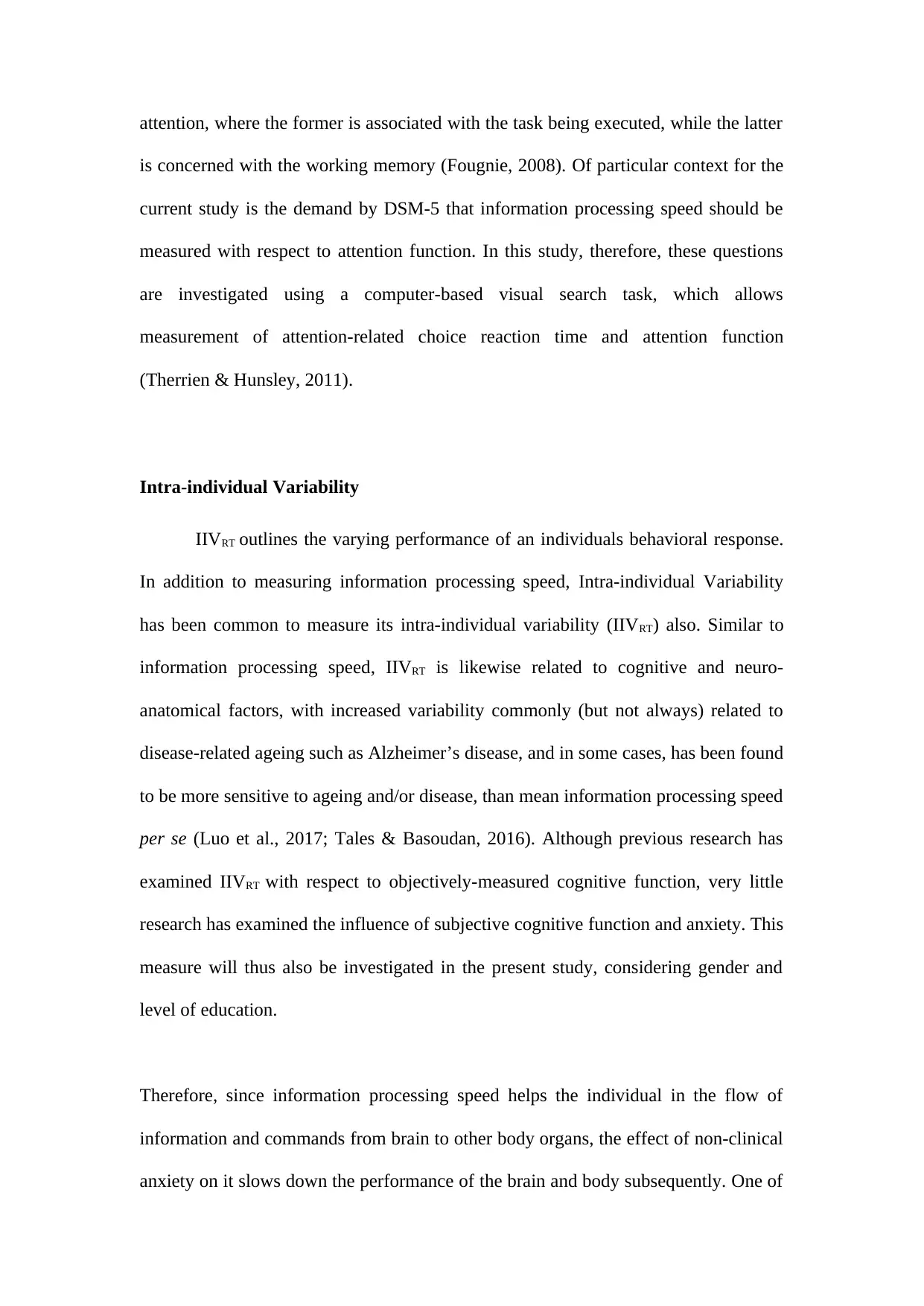
attention, where the former is associated with the task being executed, while the latter
is concerned with the working memory (Fougnie, 2008). Of particular context for the
current study is the demand by DSM-5 that information processing speed should be
measured with respect to attention function. In this study, therefore, these questions
are investigated using a computer-based visual search task, which allows
measurement of attention-related choice reaction time and attention function
(Therrien & Hunsley, 2011).
Intra-individual Variability
IIVRT outlines the varying performance of an individuals behavioral response.
In addition to measuring information processing speed, Intra-individual Variability
has been common to measure its intra-individual variability (IIVRT) also. Similar to
information processing speed, IIVRT is likewise related to cognitive and neuro-
anatomical factors, with increased variability commonly (but not always) related to
disease-related ageing such as Alzheimer’s disease, and in some cases, has been found
to be more sensitive to ageing and/or disease, than mean information processing speed
per se (Luo et al., 2017; Tales & Basoudan, 2016). Although previous research has
examined IIVRT with respect to objectively-measured cognitive function, very little
research has examined the influence of subjective cognitive function and anxiety. This
measure will thus also be investigated in the present study, considering gender and
level of education.
Therefore, since information processing speed helps the individual in the flow of
information and commands from brain to other body organs, the effect of non-clinical
anxiety on it slows down the performance of the brain and body subsequently. One of
is concerned with the working memory (Fougnie, 2008). Of particular context for the
current study is the demand by DSM-5 that information processing speed should be
measured with respect to attention function. In this study, therefore, these questions
are investigated using a computer-based visual search task, which allows
measurement of attention-related choice reaction time and attention function
(Therrien & Hunsley, 2011).
Intra-individual Variability
IIVRT outlines the varying performance of an individuals behavioral response.
In addition to measuring information processing speed, Intra-individual Variability
has been common to measure its intra-individual variability (IIVRT) also. Similar to
information processing speed, IIVRT is likewise related to cognitive and neuro-
anatomical factors, with increased variability commonly (but not always) related to
disease-related ageing such as Alzheimer’s disease, and in some cases, has been found
to be more sensitive to ageing and/or disease, than mean information processing speed
per se (Luo et al., 2017; Tales & Basoudan, 2016). Although previous research has
examined IIVRT with respect to objectively-measured cognitive function, very little
research has examined the influence of subjective cognitive function and anxiety. This
measure will thus also be investigated in the present study, considering gender and
level of education.
Therefore, since information processing speed helps the individual in the flow of
information and commands from brain to other body organs, the effect of non-clinical
anxiety on it slows down the performance of the brain and body subsequently. One of
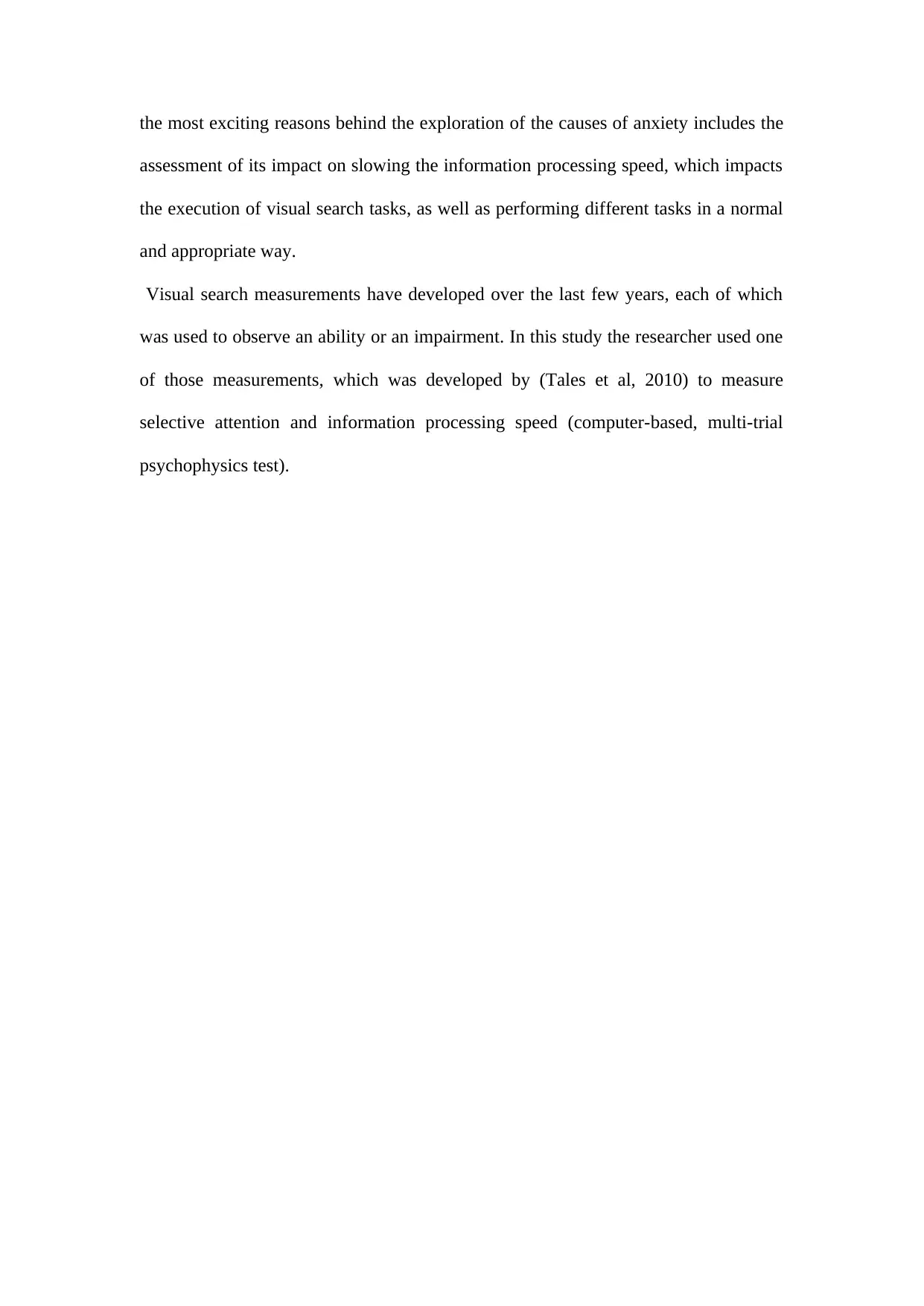
the most exciting reasons behind the exploration of the causes of anxiety includes the
assessment of its impact on slowing the information processing speed, which impacts
the execution of visual search tasks, as well as performing different tasks in a normal
and appropriate way.
Visual search measurements have developed over the last few years, each of which
was used to observe an ability or an impairment. In this study the researcher used one
of those measurements, which was developed by (Tales et al, 2010) to measure
selective attention and information processing speed (computer-based, multi-trial
psychophysics test).
assessment of its impact on slowing the information processing speed, which impacts
the execution of visual search tasks, as well as performing different tasks in a normal
and appropriate way.
Visual search measurements have developed over the last few years, each of which
was used to observe an ability or an impairment. In this study the researcher used one
of those measurements, which was developed by (Tales et al, 2010) to measure
selective attention and information processing speed (computer-based, multi-trial
psychophysics test).
Secure Best Marks with AI Grader
Need help grading? Try our AI Grader for instant feedback on your assignments.
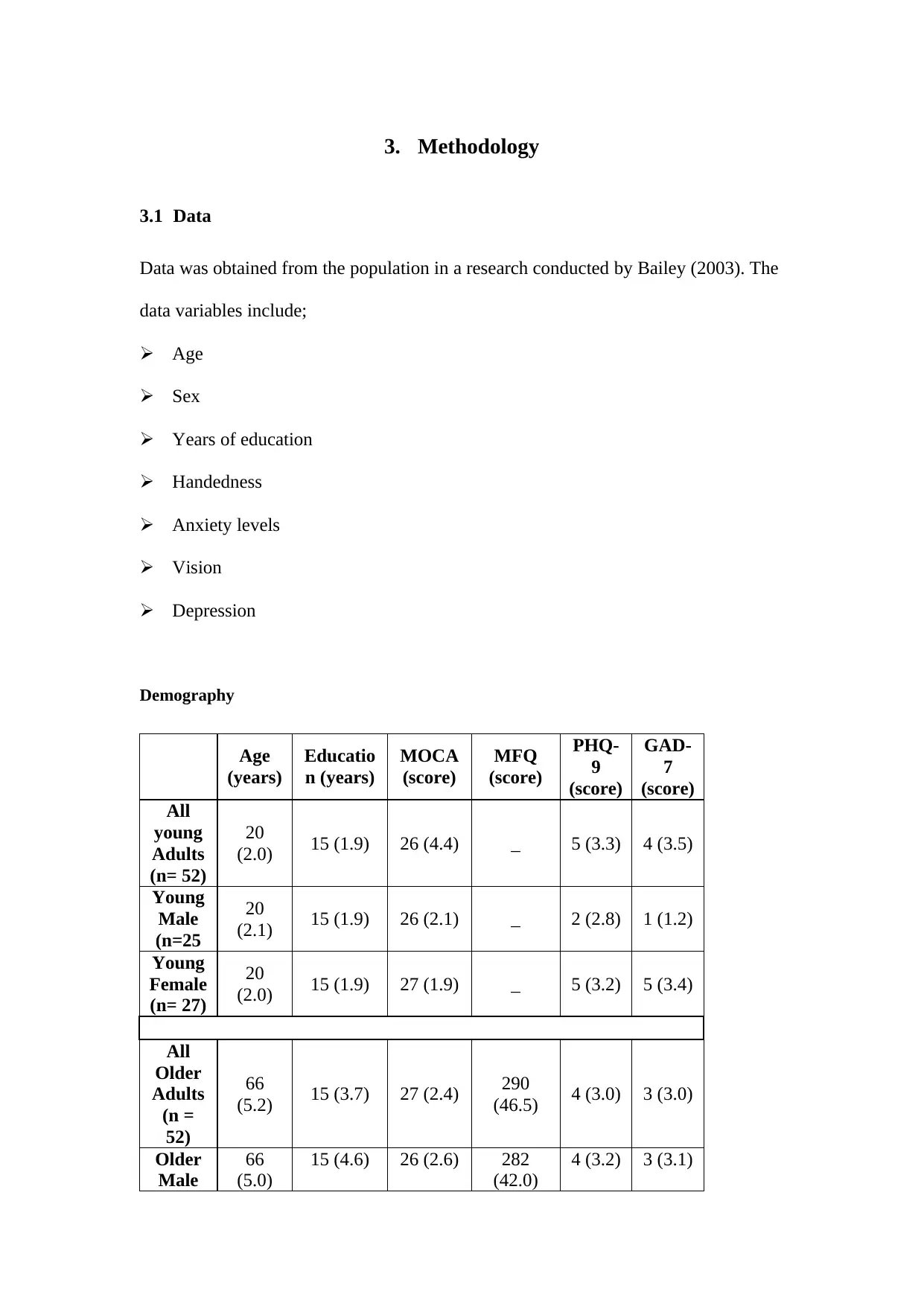
3. Methodology
3.1 Data
Data was obtained from the population in a research conducted by Bailey (2003). The
data variables include;
Age
Sex
Years of education
Handedness
Anxiety levels
Vision
Depression
Demography
Age
(years)
Educatio
n (years)
MOCA
(score)
MFQ
(score)
PHQ-
9
(score)
GAD-
7
(score)
All
young
Adults
(n= 52)
20
(2.0) 15 (1.9) 26 (4.4) _ 5 (3.3) 4 (3.5)
Young
Male
(n=25
20
(2.1) 15 (1.9) 26 (2.1) _ 2 (2.8) 1 (1.2)
Young
Female
(n= 27)
20
(2.0) 15 (1.9) 27 (1.9) _ 5 (3.2) 5 (3.4)
All
Older
Adults
(n =
52)
66
(5.2) 15 (3.7) 27 (2.4) 290
(46.5) 4 (3.0) 3 (3.0)
Older
Male
66
(5.0)
15 (4.6) 26 (2.6) 282
(42.0)
4 (3.2) 3 (3.1)
3.1 Data
Data was obtained from the population in a research conducted by Bailey (2003). The
data variables include;
Age
Sex
Years of education
Handedness
Anxiety levels
Vision
Depression
Demography
Age
(years)
Educatio
n (years)
MOCA
(score)
MFQ
(score)
PHQ-
9
(score)
GAD-
7
(score)
All
young
Adults
(n= 52)
20
(2.0) 15 (1.9) 26 (4.4) _ 5 (3.3) 4 (3.5)
Young
Male
(n=25
20
(2.1) 15 (1.9) 26 (2.1) _ 2 (2.8) 1 (1.2)
Young
Female
(n= 27)
20
(2.0) 15 (1.9) 27 (1.9) _ 5 (3.2) 5 (3.4)
All
Older
Adults
(n =
52)
66
(5.2) 15 (3.7) 27 (2.4) 290
(46.5) 4 (3.0) 3 (3.0)
Older
Male
66
(5.0)
15 (4.6) 26 (2.6) 282
(42.0)
4 (3.2) 3 (3.1)

(n=22)
Older
Female
(n=30)
55
(5.4) 15 (2.9) 28 (2.1) 295
(49.4) 3 (2.8) 3 (3.0)
3.2 Instruments
The instruments used in this research include:
i. BAI
ii. BDI,
iii. MoCA,
iv. PRMQ
v. STAI-S
vi. STAI-T
Additionally, in order to test for information processing speed, attention, and
variability, we applied the psycho-physics test.
3.3 Participants
Participants for this methodological test were 104 entrants. 52 from both sexes
distributed over the interest age groups.
3.4 Stimuli
Presentation of the stimuli was done on a Dell Precision PCm with Windows XP
operating system and X86 CPU, with a distance of 57 cm for viewing. Participants
were presented with either left-pointing arrow (>) or a right-pointing one (<), for their
response in each trial. These right and left-pointing symbols were presented either by
Older
Female
(n=30)
55
(5.4) 15 (2.9) 28 (2.1) 295
(49.4) 3 (2.8) 3 (3.0)
3.2 Instruments
The instruments used in this research include:
i. BAI
ii. BDI,
iii. MoCA,
iv. PRMQ
v. STAI-S
vi. STAI-T
Additionally, in order to test for information processing speed, attention, and
variability, we applied the psycho-physics test.
3.3 Participants
Participants for this methodological test were 104 entrants. 52 from both sexes
distributed over the interest age groups.
3.4 Stimuli
Presentation of the stimuli was done on a Dell Precision PCm with Windows XP
operating system and X86 CPU, with a distance of 57 cm for viewing. Participants
were presented with either left-pointing arrow (>) or a right-pointing one (<), for their
response in each trial. These right and left-pointing symbols were presented either by
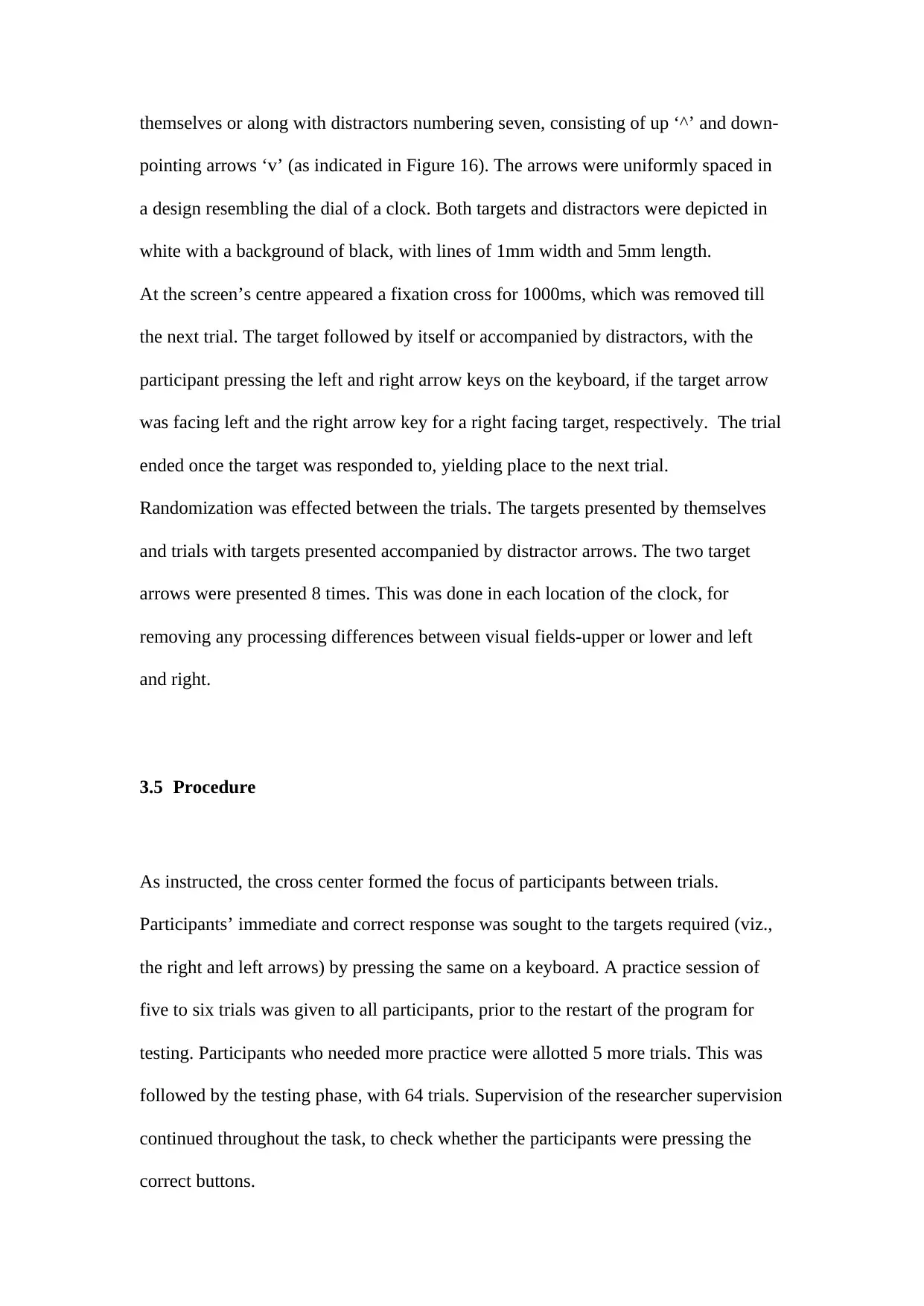
themselves or along with distractors numbering seven, consisting of up ‘^’ and down-
pointing arrows ‘v’ (as indicated in Figure 16). The arrows were uniformly spaced in
a design resembling the dial of a clock. Both targets and distractors were depicted in
white with a background of black, with lines of 1mm width and 5mm length.
At the screen’s centre appeared a fixation cross for 1000ms, which was removed till
the next trial. The target followed by itself or accompanied by distractors, with the
participant pressing the left and right arrow keys on the keyboard, if the target arrow
was facing left and the right arrow key for a right facing target, respectively. The trial
ended once the target was responded to, yielding place to the next trial.
Randomization was effected between the trials. The targets presented by themselves
and trials with targets presented accompanied by distractor arrows. The two target
arrows were presented 8 times. This was done in each location of the clock, for
removing any processing differences between visual fields-upper or lower and left
and right.
3.5 Procedure
As instructed, the cross center formed the focus of participants between trials.
Participants’ immediate and correct response was sought to the targets required (viz.,
the right and left arrows) by pressing the same on a keyboard. A practice session of
five to six trials was given to all participants, prior to the restart of the program for
testing. Participants who needed more practice were allotted 5 more trials. This was
followed by the testing phase, with 64 trials. Supervision of the researcher supervision
continued throughout the task, to check whether the participants were pressing the
correct buttons.
pointing arrows ‘v’ (as indicated in Figure 16). The arrows were uniformly spaced in
a design resembling the dial of a clock. Both targets and distractors were depicted in
white with a background of black, with lines of 1mm width and 5mm length.
At the screen’s centre appeared a fixation cross for 1000ms, which was removed till
the next trial. The target followed by itself or accompanied by distractors, with the
participant pressing the left and right arrow keys on the keyboard, if the target arrow
was facing left and the right arrow key for a right facing target, respectively. The trial
ended once the target was responded to, yielding place to the next trial.
Randomization was effected between the trials. The targets presented by themselves
and trials with targets presented accompanied by distractor arrows. The two target
arrows were presented 8 times. This was done in each location of the clock, for
removing any processing differences between visual fields-upper or lower and left
and right.
3.5 Procedure
As instructed, the cross center formed the focus of participants between trials.
Participants’ immediate and correct response was sought to the targets required (viz.,
the right and left arrows) by pressing the same on a keyboard. A practice session of
five to six trials was given to all participants, prior to the restart of the program for
testing. Participants who needed more practice were allotted 5 more trials. This was
followed by the testing phase, with 64 trials. Supervision of the researcher supervision
continued throughout the task, to check whether the participants were pressing the
correct buttons.
Paraphrase This Document
Need a fresh take? Get an instant paraphrase of this document with our AI Paraphraser
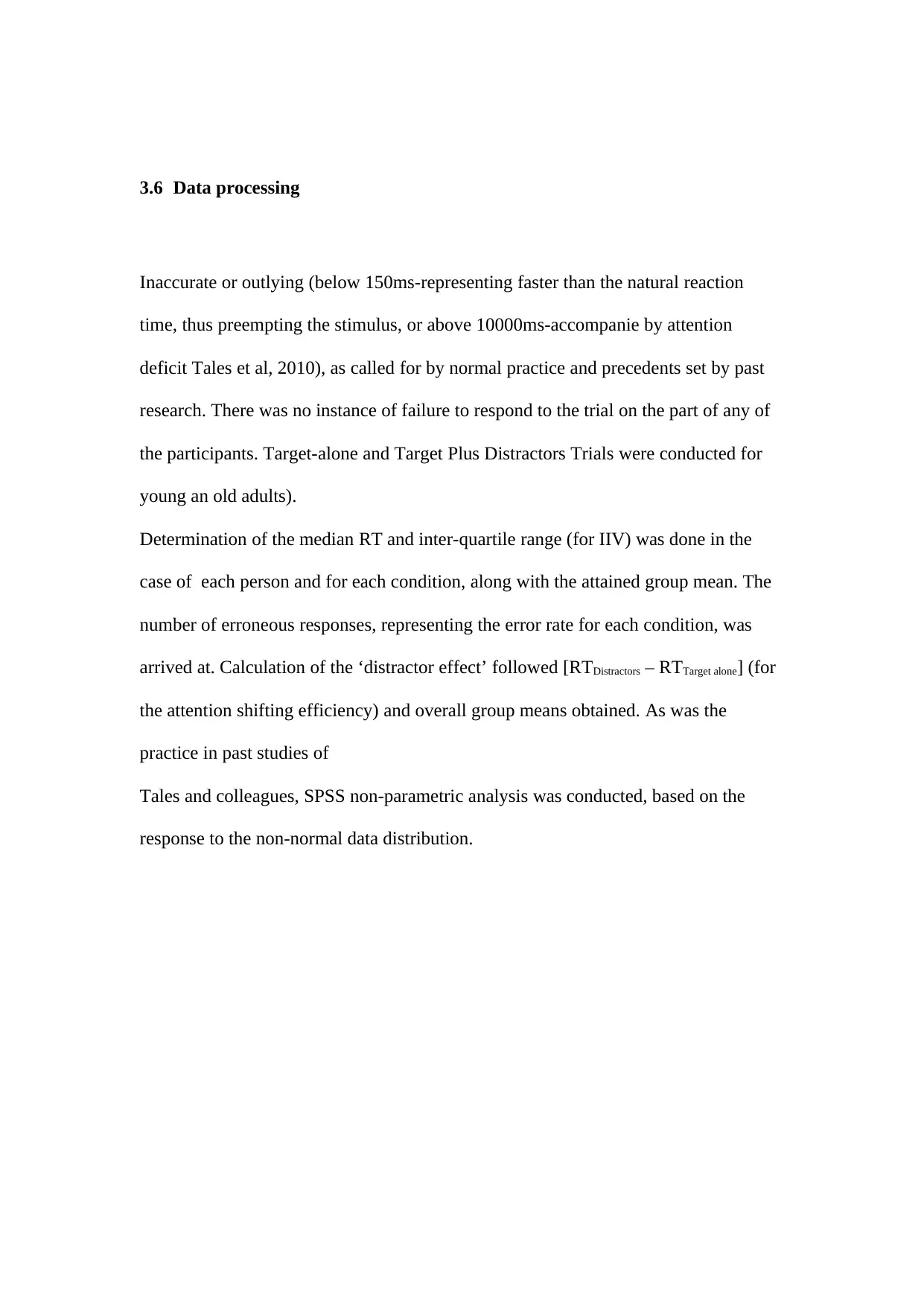
3.6 Data processing
Inaccurate or outlying (below 150ms-representing faster than the natural reaction
time, thus preempting the stimulus, or above 10000ms-accompanie by attention
deficit Tales et al, 2010), as called for by normal practice and precedents set by past
research. There was no instance of failure to respond to the trial on the part of any of
the participants. Target-alone and Target Plus Distractors Trials were conducted for
young an old adults).
Determination of the median RT and inter-quartile range (for IIV) was done in the
case of each person and for each condition, along with the attained group mean. The
number of erroneous responses, representing the error rate for each condition, was
arrived at. Calculation of the ‘distractor effect’ followed [RTDistractors – RTTarget alone] (for
the attention shifting efficiency) and overall group means obtained. As was the
practice in past studies of
Tales and colleagues, SPSS non-parametric analysis was conducted, based on the
response to the non-normal data distribution.
Inaccurate or outlying (below 150ms-representing faster than the natural reaction
time, thus preempting the stimulus, or above 10000ms-accompanie by attention
deficit Tales et al, 2010), as called for by normal practice and precedents set by past
research. There was no instance of failure to respond to the trial on the part of any of
the participants. Target-alone and Target Plus Distractors Trials were conducted for
young an old adults).
Determination of the median RT and inter-quartile range (for IIV) was done in the
case of each person and for each condition, along with the attained group mean. The
number of erroneous responses, representing the error rate for each condition, was
arrived at. Calculation of the ‘distractor effect’ followed [RTDistractors – RTTarget alone] (for
the attention shifting efficiency) and overall group means obtained. As was the
practice in past studies of
Tales and colleagues, SPSS non-parametric analysis was conducted, based on the
response to the non-normal data distribution.
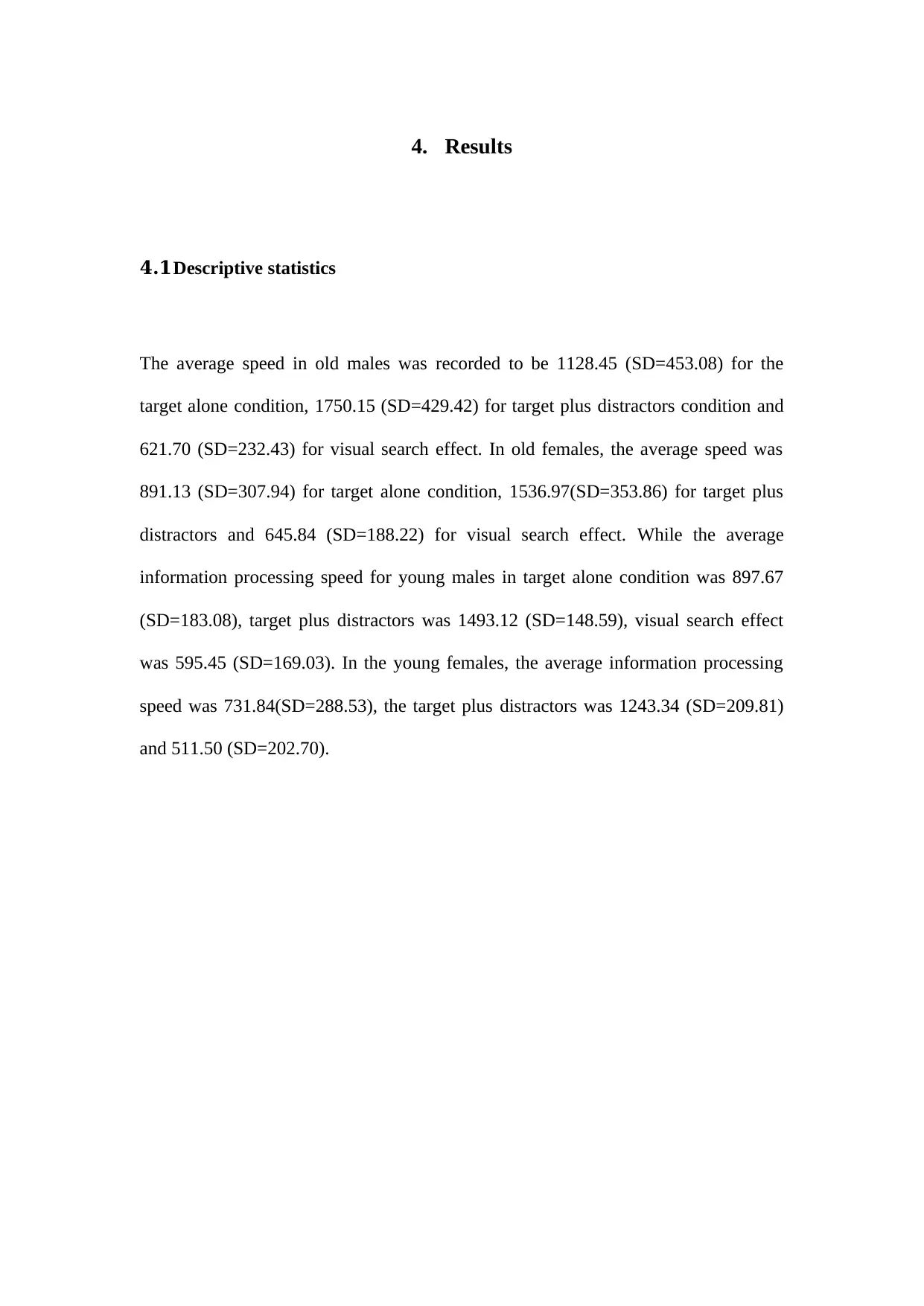
4. Results
4.1Descriptive statistics
The average speed in old males was recorded to be 1128.45 (SD=453.08) for the
target alone condition, 1750.15 (SD=429.42) for target plus distractors condition and
621.70 (SD=232.43) for visual search effect. In old females, the average speed was
891.13 (SD=307.94) for target alone condition, 1536.97(SD=353.86) for target plus
distractors and 645.84 (SD=188.22) for visual search effect. While the average
information processing speed for young males in target alone condition was 897.67
(SD=183.08), target plus distractors was 1493.12 (SD=148.59), visual search effect
was 595.45 (SD=169.03). In the young females, the average information processing
speed was 731.84(SD=288.53), the target plus distractors was 1243.34 (SD=209.81)
and 511.50 (SD=202.70).
4.1Descriptive statistics
The average speed in old males was recorded to be 1128.45 (SD=453.08) for the
target alone condition, 1750.15 (SD=429.42) for target plus distractors condition and
621.70 (SD=232.43) for visual search effect. In old females, the average speed was
891.13 (SD=307.94) for target alone condition, 1536.97(SD=353.86) for target plus
distractors and 645.84 (SD=188.22) for visual search effect. While the average
information processing speed for young males in target alone condition was 897.67
(SD=183.08), target plus distractors was 1493.12 (SD=148.59), visual search effect
was 595.45 (SD=169.03). In the young females, the average information processing
speed was 731.84(SD=288.53), the target plus distractors was 1243.34 (SD=209.81)
and 511.50 (SD=202.70).
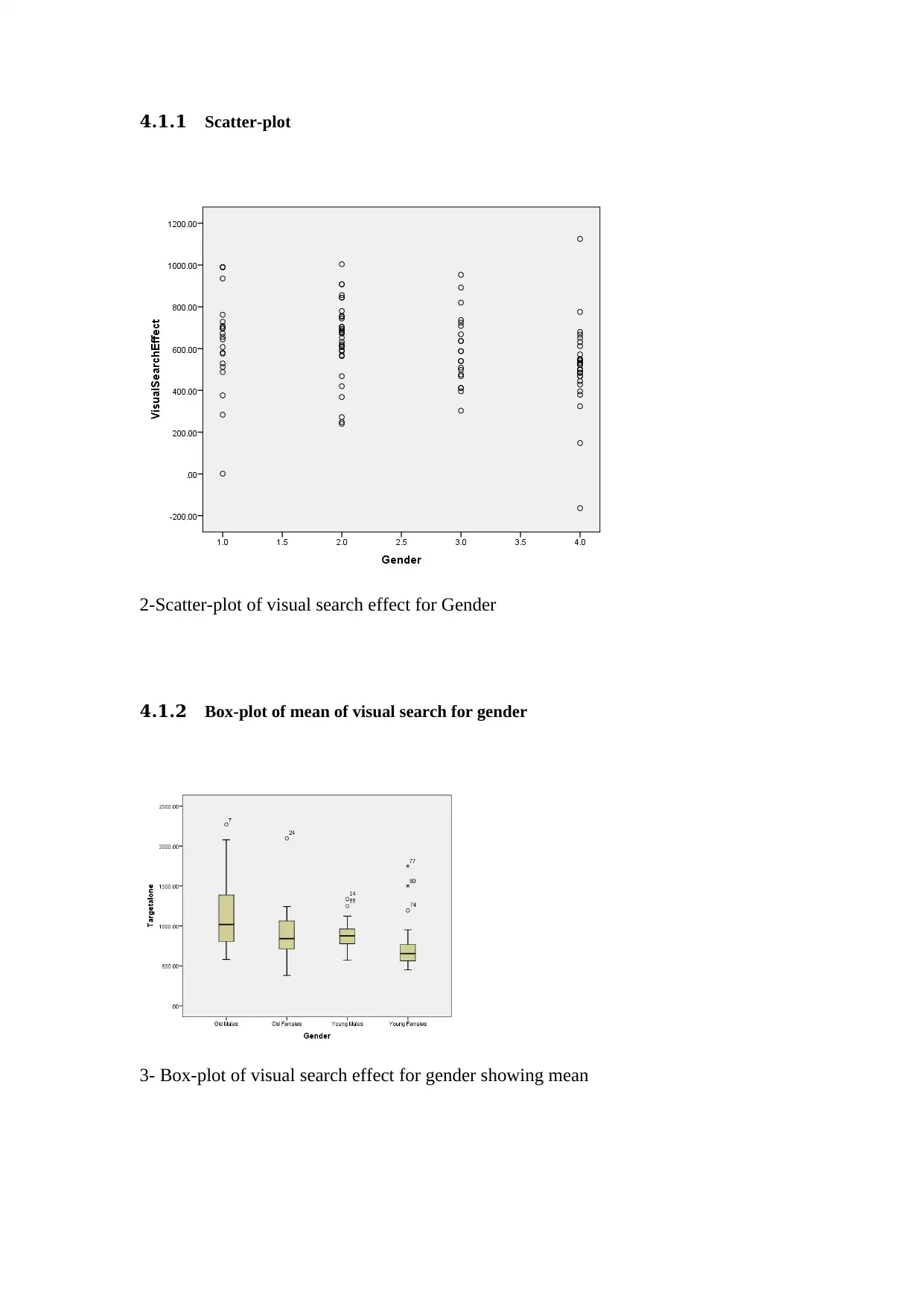
4.1.1 Scatter-plot
2-Scatter-plot of visual search effect for Gender
4.1.2 Box-plot of mean of visual search for gender
3- Box-plot of visual search effect for gender showing mean
2-Scatter-plot of visual search effect for Gender
4.1.2 Box-plot of mean of visual search for gender
3- Box-plot of visual search effect for gender showing mean
Secure Best Marks with AI Grader
Need help grading? Try our AI Grader for instant feedback on your assignments.

4.2Inferential Statistics
Following the Mann-Whitney U test for significant difference in information
processing speed between old males and old females. We found out that: information
processing speed was no significant difference between old males and old females in
the target alone, target plus distractors and the visual search effect, (U=217.00,
p=0.053, effect size=0.074), (U=226.00, p=0.077, effect size=0.061) and (U=298.50,
p=0.686, effect size=0.003). In contrast, in the test for significant difference in
information processing speed between young males and females, There was a
significant difference in information processing speed in target alone condition
between young males and young females, i.e. (U=131.00, p=0.00, effect size=0.26).
Similarly, the speed in target plus distractors condition is significantly different
between young males and young females (U=118.00, p=0.00, effect size=0.29).
Lastly, there is no significance difference in the visual search effect between young
males and young females, (U=248.00, p=0.15, effect size=0.04).
4.3Tests
4.3.1 Normality test for age
Based on Shapiro-Wilkes Test, the response time in the target alone condition is not
normally distributed in both the old and the young group, p<0.05. The response time
Following the Mann-Whitney U test for significant difference in information
processing speed between old males and old females. We found out that: information
processing speed was no significant difference between old males and old females in
the target alone, target plus distractors and the visual search effect, (U=217.00,
p=0.053, effect size=0.074), (U=226.00, p=0.077, effect size=0.061) and (U=298.50,
p=0.686, effect size=0.003). In contrast, in the test for significant difference in
information processing speed between young males and females, There was a
significant difference in information processing speed in target alone condition
between young males and young females, i.e. (U=131.00, p=0.00, effect size=0.26).
Similarly, the speed in target plus distractors condition is significantly different
between young males and young females (U=118.00, p=0.00, effect size=0.29).
Lastly, there is no significance difference in the visual search effect between young
males and young females, (U=248.00, p=0.15, effect size=0.04).
4.3Tests
4.3.1 Normality test for age
Based on Shapiro-Wilkes Test, the response time in the target alone condition is not
normally distributed in both the old and the young group, p<0.05. The response time
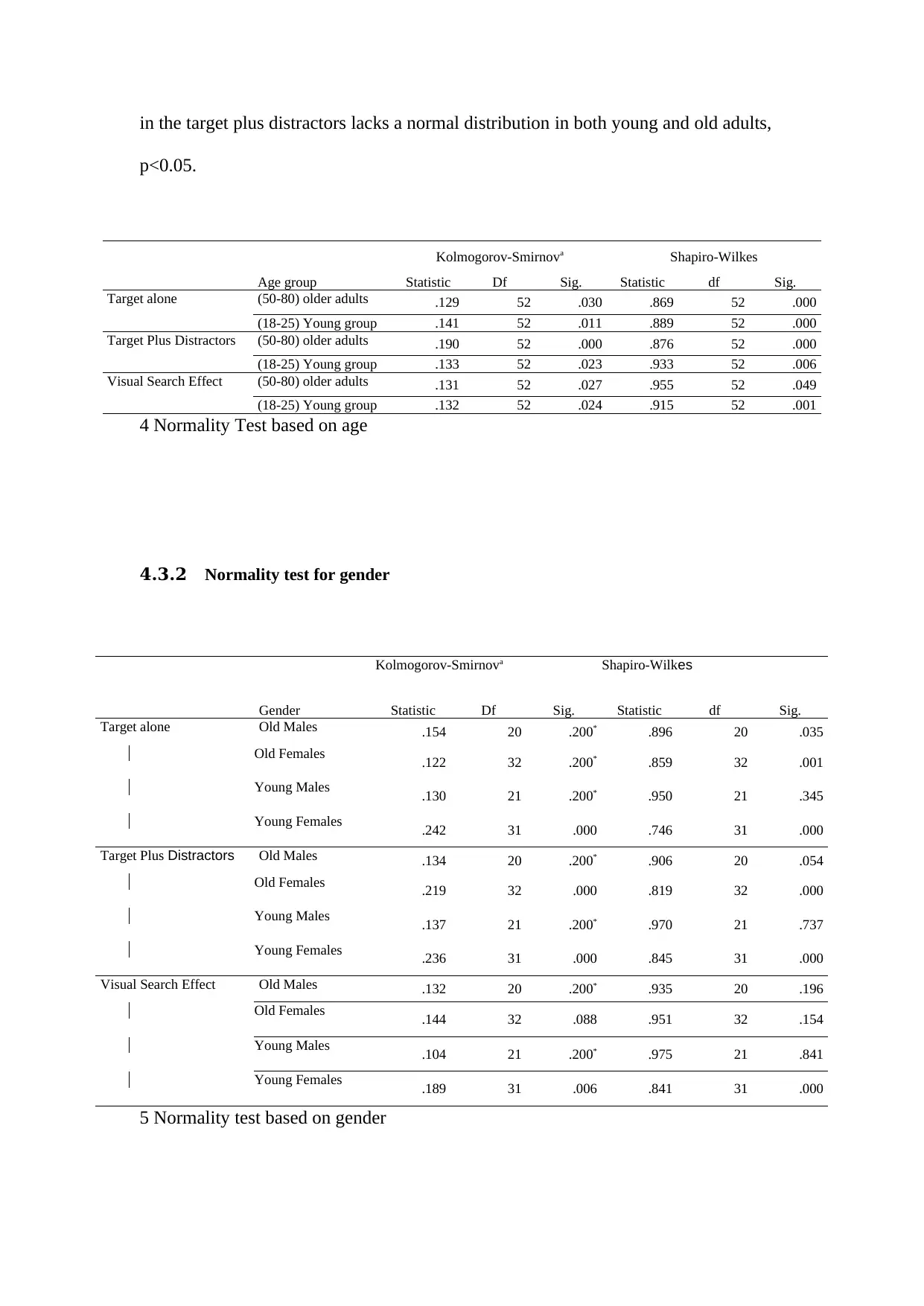
in the target plus distractors lacks a normal distribution in both young and old adults,
p<0.05.
Age group
Kolmogorov-Smirnova Shapiro-Wilkes
Statistic Df Sig. Statistic df Sig.
Target alone (50-80) older adults .129 52 .030 .869 52 .000
(18-25) Young group .141 52 .011 .889 52 .000
Target Plus Distractors (50-80) older adults .190 52 .000 .876 52 .000
(18-25) Young group .133 52 .023 .933 52 .006
Visual Search Effect (50-80) older adults .131 52 .027 .955 52 .049
(18-25) Young group .132 52 .024 .915 52 .001
4 Normality Test based on age
4.3.2 Normality test for gender
Gender
Kolmogorov-Smirnova Shapiro-Wilkes
Statistic Df Sig. Statistic df Sig.
Target alone Old Males .154 20 .200* .896 20 .035
Old Females .122 32 .200* .859 32 .001
Young Males .130 21 .200* .950 21 .345
Young Females .242 31 .000 .746 31 .000
Target Plus Distractors Old Males .134 20 .200* .906 20 .054
Old Females .219 32 .000 .819 32 .000
Young Males .137 21 .200* .970 21 .737
Young Females .236 31 .000 .845 31 .000
Visual Search Effect Old Males .132 20 .200* .935 20 .196
Old Females .144 32 .088 .951 32 .154
Young Males .104 21 .200* .975 21 .841
Young Females .189 31 .006 .841 31 .000
5 Normality test based on gender
p<0.05.
Age group
Kolmogorov-Smirnova Shapiro-Wilkes
Statistic Df Sig. Statistic df Sig.
Target alone (50-80) older adults .129 52 .030 .869 52 .000
(18-25) Young group .141 52 .011 .889 52 .000
Target Plus Distractors (50-80) older adults .190 52 .000 .876 52 .000
(18-25) Young group .133 52 .023 .933 52 .006
Visual Search Effect (50-80) older adults .131 52 .027 .955 52 .049
(18-25) Young group .132 52 .024 .915 52 .001
4 Normality Test based on age
4.3.2 Normality test for gender
Gender
Kolmogorov-Smirnova Shapiro-Wilkes
Statistic Df Sig. Statistic df Sig.
Target alone Old Males .154 20 .200* .896 20 .035
Old Females .122 32 .200* .859 32 .001
Young Males .130 21 .200* .950 21 .345
Young Females .242 31 .000 .746 31 .000
Target Plus Distractors Old Males .134 20 .200* .906 20 .054
Old Females .219 32 .000 .819 32 .000
Young Males .137 21 .200* .970 21 .737
Young Females .236 31 .000 .845 31 .000
Visual Search Effect Old Males .132 20 .200* .935 20 .196
Old Females .144 32 .088 .951 32 .154
Young Males .104 21 .200* .975 21 .841
Young Females .189 31 .006 .841 31 .000
5 Normality test based on gender
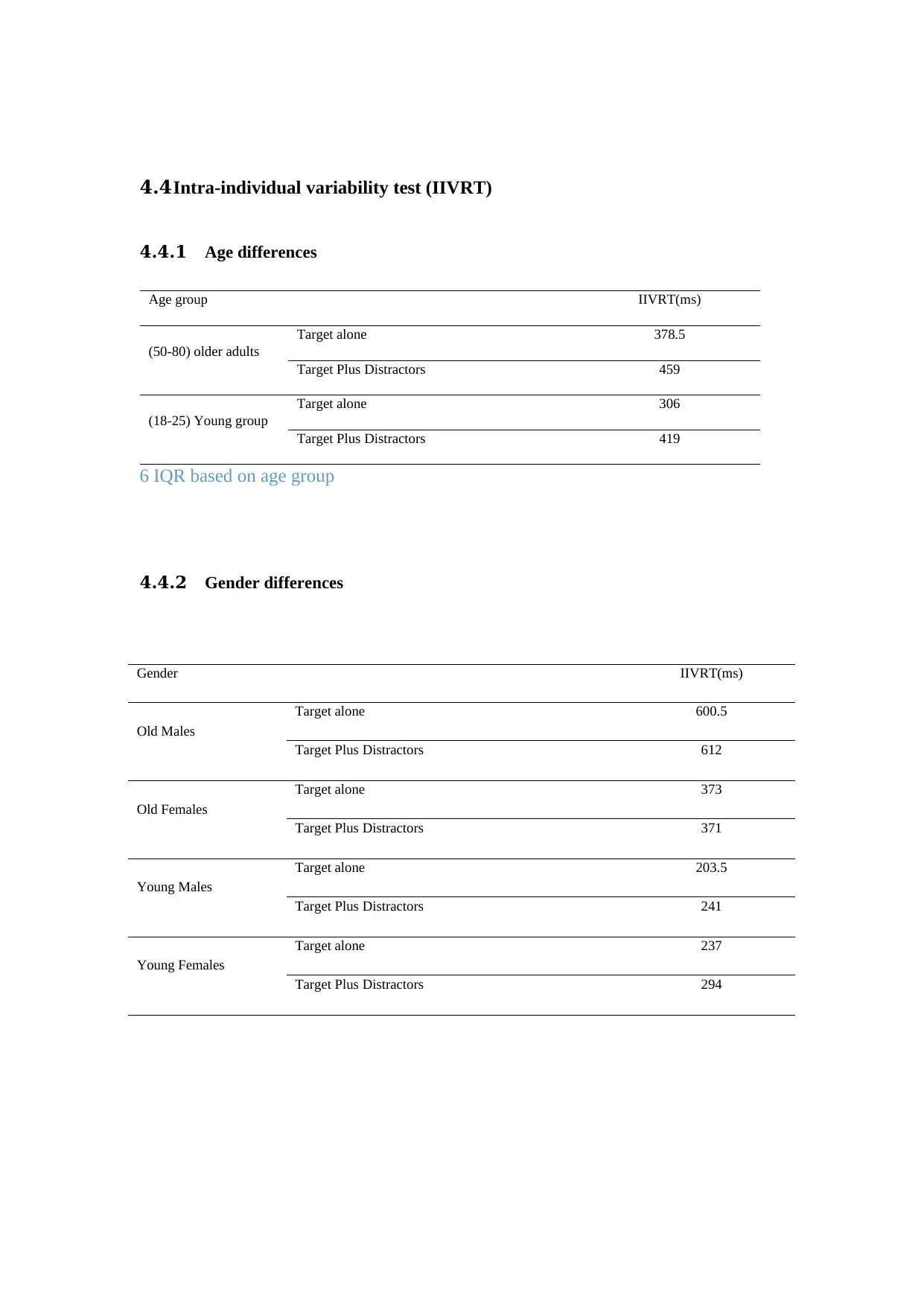
4.4Intra-individual variability test (IIVRT)
4.4.1 Age differences
Age group IIVRT(ms)
(50-80) older adults
Target alone 378.5
Target Plus Distractors 459
(18-25) Young group
Target alone 306
Target Plus Distractors 419
6 IQR based on age group
4.4.2 Gender differences
Gender IIVRT(ms)
Old Males
Target alone 600.5
Target Plus Distractors 612
Old Females
Target alone 373
Target Plus Distractors 371
Young Males
Target alone 203.5
Target Plus Distractors 241
Young Females
Target alone 237
Target Plus Distractors 294
4.4.1 Age differences
Age group IIVRT(ms)
(50-80) older adults
Target alone 378.5
Target Plus Distractors 459
(18-25) Young group
Target alone 306
Target Plus Distractors 419
6 IQR based on age group
4.4.2 Gender differences
Gender IIVRT(ms)
Old Males
Target alone 600.5
Target Plus Distractors 612
Old Females
Target alone 373
Target Plus Distractors 371
Young Males
Target alone 203.5
Target Plus Distractors 241
Young Females
Target alone 237
Target Plus Distractors 294
Paraphrase This Document
Need a fresh take? Get an instant paraphrase of this document with our AI Paraphraser
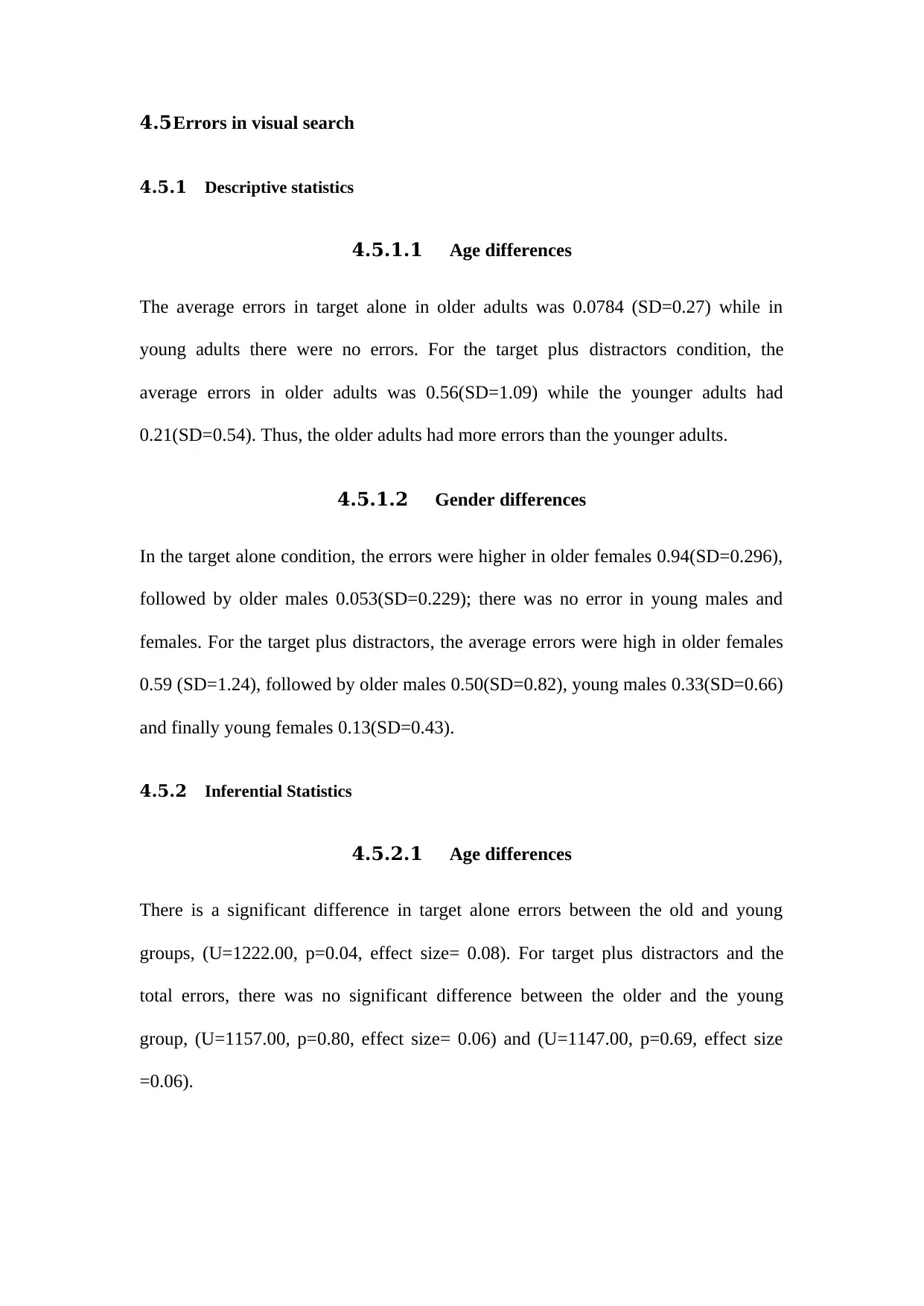
4.5Errors in visual search
4.5.1 Descriptive statistics
4.5.1.1 Age differences
The average errors in target alone in older adults was 0.0784 (SD=0.27) while in
young adults there were no errors. For the target plus distractors condition, the
average errors in older adults was 0.56(SD=1.09) while the younger adults had
0.21(SD=0.54). Thus, the older adults had more errors than the younger adults.
4.5.1.2 Gender differences
In the target alone condition, the errors were higher in older females 0.94(SD=0.296),
followed by older males 0.053(SD=0.229); there was no error in young males and
females. For the target plus distractors, the average errors were high in older females
0.59 (SD=1.24), followed by older males 0.50(SD=0.82), young males 0.33(SD=0.66)
and finally young females 0.13(SD=0.43).
4.5.2 Inferential Statistics
4.5.2.1 Age differences
There is a significant difference in target alone errors between the old and young
groups, (U=1222.00, p=0.04, effect size= 0.08). For target plus distractors and the
total errors, there was no significant difference between the older and the young
group, (U=1157.00, p=0.80, effect size= 0.06) and (U=1147.00, p=0.69, effect size
=0.06).
4.5.1 Descriptive statistics
4.5.1.1 Age differences
The average errors in target alone in older adults was 0.0784 (SD=0.27) while in
young adults there were no errors. For the target plus distractors condition, the
average errors in older adults was 0.56(SD=1.09) while the younger adults had
0.21(SD=0.54). Thus, the older adults had more errors than the younger adults.
4.5.1.2 Gender differences
In the target alone condition, the errors were higher in older females 0.94(SD=0.296),
followed by older males 0.053(SD=0.229); there was no error in young males and
females. For the target plus distractors, the average errors were high in older females
0.59 (SD=1.24), followed by older males 0.50(SD=0.82), young males 0.33(SD=0.66)
and finally young females 0.13(SD=0.43).
4.5.2 Inferential Statistics
4.5.2.1 Age differences
There is a significant difference in target alone errors between the old and young
groups, (U=1222.00, p=0.04, effect size= 0.08). For target plus distractors and the
total errors, there was no significant difference between the older and the young
group, (U=1157.00, p=0.80, effect size= 0.06) and (U=1147.00, p=0.69, effect size
=0.06).
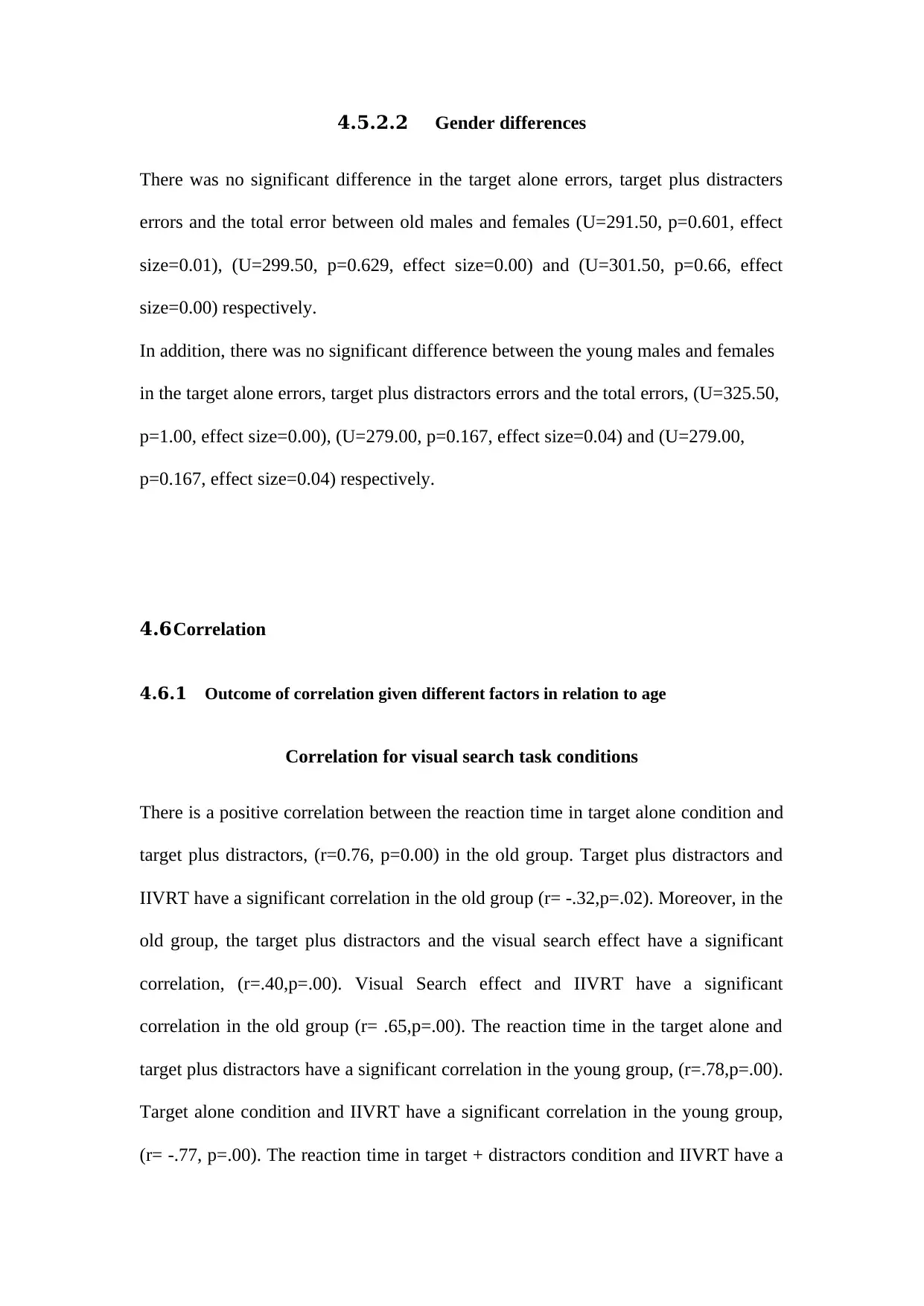
4.5.2.2 Gender differences
There was no significant difference in the target alone errors, target plus distracters
errors and the total error between old males and females (U=291.50, p=0.601, effect
size=0.01), (U=299.50, p=0.629, effect size=0.00) and (U=301.50, p=0.66, effect
size=0.00) respectively.
In addition, there was no significant difference between the young males and females
in the target alone errors, target plus distractors errors and the total errors, (U=325.50,
p=1.00, effect size=0.00), (U=279.00, p=0.167, effect size=0.04) and (U=279.00,
p=0.167, effect size=0.04) respectively.
4.6Correlation
4.6.1 Outcome of correlation given different factors in relation to age
Correlation for visual search task conditions
There is a positive correlation between the reaction time in target alone condition and
target plus distractors, (r=0.76, p=0.00) in the old group. Target plus distractors and
IIVRT have a significant correlation in the old group (r= -.32,p=.02). Moreover, in the
old group, the target plus distractors and the visual search effect have a significant
correlation, (r=.40,p=.00). Visual Search effect and IIVRT have a significant
correlation in the old group (r= .65,p=.00). The reaction time in the target alone and
target plus distractors have a significant correlation in the young group, (r=.78,p=.00).
Target alone condition and IIVRT have a significant correlation in the young group,
(r= -.77, p=.00). The reaction time in target + distractors condition and IIVRT have a
There was no significant difference in the target alone errors, target plus distracters
errors and the total error between old males and females (U=291.50, p=0.601, effect
size=0.01), (U=299.50, p=0.629, effect size=0.00) and (U=301.50, p=0.66, effect
size=0.00) respectively.
In addition, there was no significant difference between the young males and females
in the target alone errors, target plus distractors errors and the total errors, (U=325.50,
p=1.00, effect size=0.00), (U=279.00, p=0.167, effect size=0.04) and (U=279.00,
p=0.167, effect size=0.04) respectively.
4.6Correlation
4.6.1 Outcome of correlation given different factors in relation to age
Correlation for visual search task conditions
There is a positive correlation between the reaction time in target alone condition and
target plus distractors, (r=0.76, p=0.00) in the old group. Target plus distractors and
IIVRT have a significant correlation in the old group (r= -.32,p=.02). Moreover, in the
old group, the target plus distractors and the visual search effect have a significant
correlation, (r=.40,p=.00). Visual Search effect and IIVRT have a significant
correlation in the old group (r= .65,p=.00). The reaction time in the target alone and
target plus distractors have a significant correlation in the young group, (r=.78,p=.00).
Target alone condition and IIVRT have a significant correlation in the young group,
(r= -.77, p=.00). The reaction time in target + distractors condition and IIVRT have a
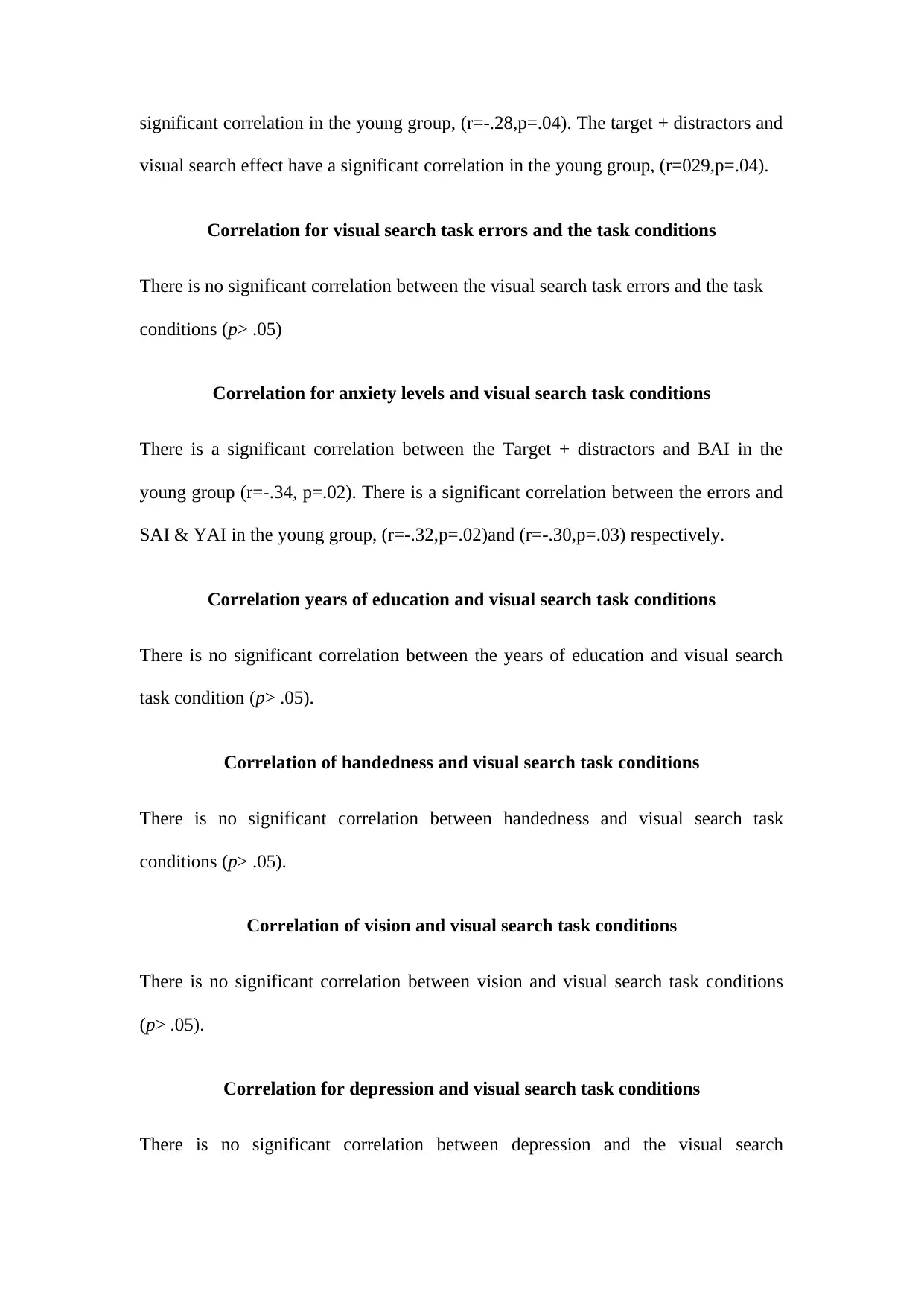
significant correlation in the young group, (r=-.28,p=.04). The target + distractors and
visual search effect have a significant correlation in the young group, (r=029,p=.04).
Correlation for visual search task errors and the task conditions
There is no significant correlation between the visual search task errors and the task
conditions (p> .05)
Correlation for anxiety levels and visual search task conditions
There is a significant correlation between the Target + distractors and BAI in the
young group (r=-.34, p=.02). There is a significant correlation between the errors and
SAI & YAI in the young group, (r=-.32,p=.02)and (r=-.30,p=.03) respectively.
Correlation years of education and visual search task conditions
There is no significant correlation between the years of education and visual search
task condition (p> .05).
Correlation of handedness and visual search task conditions
There is no significant correlation between handedness and visual search task
conditions (p> .05).
Correlation of vision and visual search task conditions
There is no significant correlation between vision and visual search task conditions
(p> .05).
Correlation for depression and visual search task conditions
There is no significant correlation between depression and the visual search
visual search effect have a significant correlation in the young group, (r=029,p=.04).
Correlation for visual search task errors and the task conditions
There is no significant correlation between the visual search task errors and the task
conditions (p> .05)
Correlation for anxiety levels and visual search task conditions
There is a significant correlation between the Target + distractors and BAI in the
young group (r=-.34, p=.02). There is a significant correlation between the errors and
SAI & YAI in the young group, (r=-.32,p=.02)and (r=-.30,p=.03) respectively.
Correlation years of education and visual search task conditions
There is no significant correlation between the years of education and visual search
task condition (p> .05).
Correlation of handedness and visual search task conditions
There is no significant correlation between handedness and visual search task
conditions (p> .05).
Correlation of vision and visual search task conditions
There is no significant correlation between vision and visual search task conditions
(p> .05).
Correlation for depression and visual search task conditions
There is no significant correlation between depression and the visual search
Secure Best Marks with AI Grader
Need help grading? Try our AI Grader for instant feedback on your assignments.
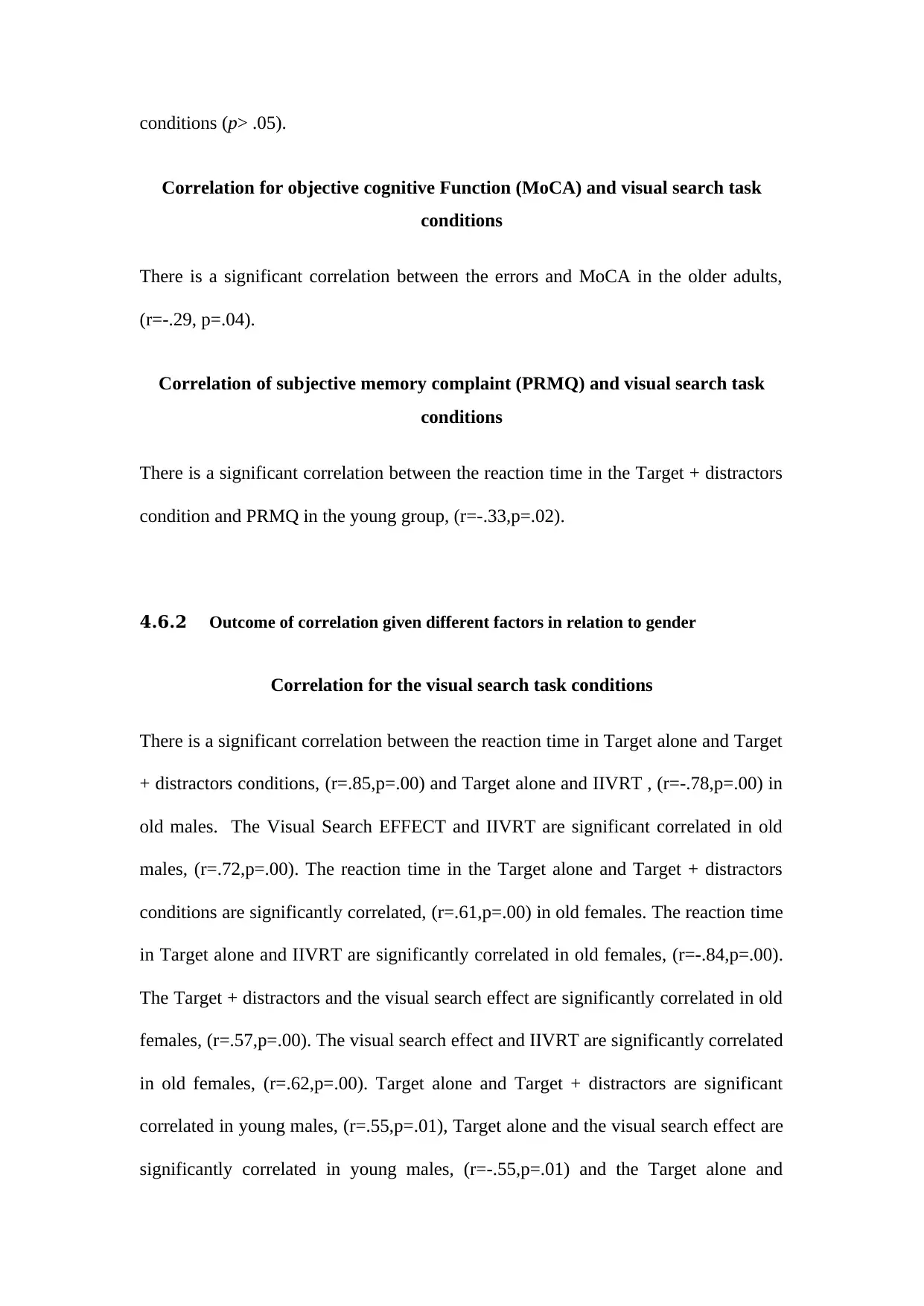
conditions (p> .05).
Correlation for objective cognitive Function (MoCA) and visual search task
conditions
There is a significant correlation between the errors and MoCA in the older adults,
(r=-.29, p=.04).
Correlation of subjective memory complaint (PRMQ) and visual search task
conditions
There is a significant correlation between the reaction time in the Target + distractors
condition and PRMQ in the young group, (r=-.33,p=.02).
4.6.2 Outcome of correlation given different factors in relation to gender
Correlation for the visual search task conditions
There is a significant correlation between the reaction time in Target alone and Target
+ distractors conditions, (r=.85,p=.00) and Target alone and IIVRT , (r=-.78,p=.00) in
old males. The Visual Search EFFECT and IIVRT are significant correlated in old
males, (r=.72,p=.00). The reaction time in the Target alone and Target + distractors
conditions are significantly correlated, (r=.61,p=.00) in old females. The reaction time
in Target alone and IIVRT are significantly correlated in old females, (r=-.84,p=.00).
The Target + distractors and the visual search effect are significantly correlated in old
females, (r=.57,p=.00). The visual search effect and IIVRT are significantly correlated
in old females, (r=.62,p=.00). Target alone and Target + distractors are significant
correlated in young males, (r=.55,p=.01), Target alone and the visual search effect are
significantly correlated in young males, (r=-.55,p=.01) and the Target alone and
Correlation for objective cognitive Function (MoCA) and visual search task
conditions
There is a significant correlation between the errors and MoCA in the older adults,
(r=-.29, p=.04).
Correlation of subjective memory complaint (PRMQ) and visual search task
conditions
There is a significant correlation between the reaction time in the Target + distractors
condition and PRMQ in the young group, (r=-.33,p=.02).
4.6.2 Outcome of correlation given different factors in relation to gender
Correlation for the visual search task conditions
There is a significant correlation between the reaction time in Target alone and Target
+ distractors conditions, (r=.85,p=.00) and Target alone and IIVRT , (r=-.78,p=.00) in
old males. The Visual Search EFFECT and IIVRT are significant correlated in old
males, (r=.72,p=.00). The reaction time in the Target alone and Target + distractors
conditions are significantly correlated, (r=.61,p=.00) in old females. The reaction time
in Target alone and IIVRT are significantly correlated in old females, (r=-.84,p=.00).
The Target + distractors and the visual search effect are significantly correlated in old
females, (r=.57,p=.00). The visual search effect and IIVRT are significantly correlated
in old females, (r=.62,p=.00). Target alone and Target + distractors are significant
correlated in young males, (r=.55,p=.01), Target alone and the visual search effect are
significantly correlated in young males, (r=-.55,p=.01) and the Target alone and
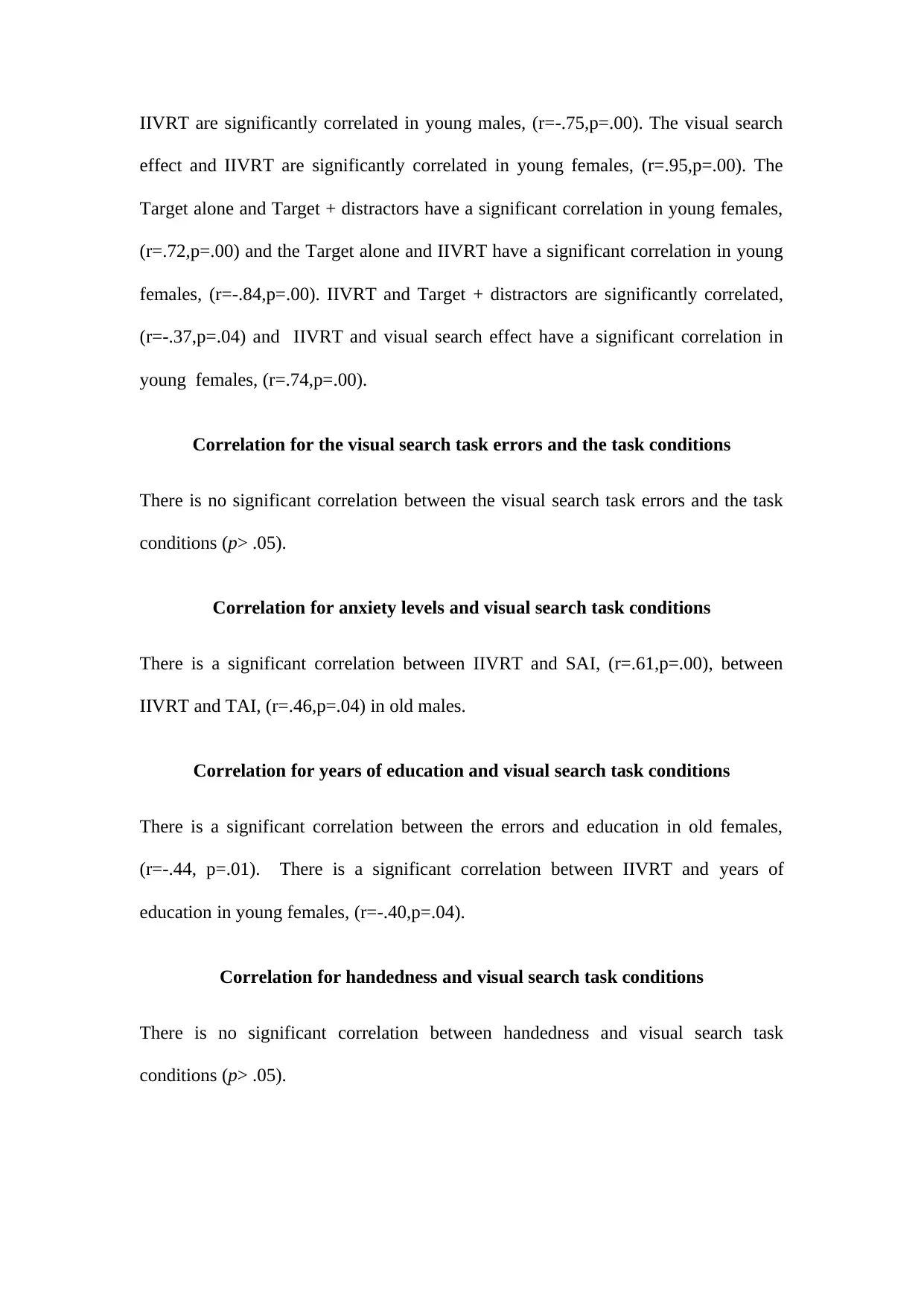
IIVRT are significantly correlated in young males, (r=-.75,p=.00). The visual search
effect and IIVRT are significantly correlated in young females, (r=.95,p=.00). The
Target alone and Target + distractors have a significant correlation in young females,
(r=.72,p=.00) and the Target alone and IIVRT have a significant correlation in young
females, (r=-.84,p=.00). IIVRT and Target + distractors are significantly correlated,
(r=-.37,p=.04) and IIVRT and visual search effect have a significant correlation in
young females, (r=.74,p=.00).
Correlation for the visual search task errors and the task conditions
There is no significant correlation between the visual search task errors and the task
conditions (p> .05).
Correlation for anxiety levels and visual search task conditions
There is a significant correlation between IIVRT and SAI, (r=.61,p=.00), between
IIVRT and TAI, (r=.46,p=.04) in old males.
Correlation for years of education and visual search task conditions
There is a significant correlation between the errors and education in old females,
(r=-.44, p=.01). There is a significant correlation between IIVRT and years of
education in young females, (r=-.40,p=.04).
Correlation for handedness and visual search task conditions
There is no significant correlation between handedness and visual search task
conditions (p> .05).
effect and IIVRT are significantly correlated in young females, (r=.95,p=.00). The
Target alone and Target + distractors have a significant correlation in young females,
(r=.72,p=.00) and the Target alone and IIVRT have a significant correlation in young
females, (r=-.84,p=.00). IIVRT and Target + distractors are significantly correlated,
(r=-.37,p=.04) and IIVRT and visual search effect have a significant correlation in
young females, (r=.74,p=.00).
Correlation for the visual search task errors and the task conditions
There is no significant correlation between the visual search task errors and the task
conditions (p> .05).
Correlation for anxiety levels and visual search task conditions
There is a significant correlation between IIVRT and SAI, (r=.61,p=.00), between
IIVRT and TAI, (r=.46,p=.04) in old males.
Correlation for years of education and visual search task conditions
There is a significant correlation between the errors and education in old females,
(r=-.44, p=.01). There is a significant correlation between IIVRT and years of
education in young females, (r=-.40,p=.04).
Correlation for handedness and visual search task conditions
There is no significant correlation between handedness and visual search task
conditions (p> .05).
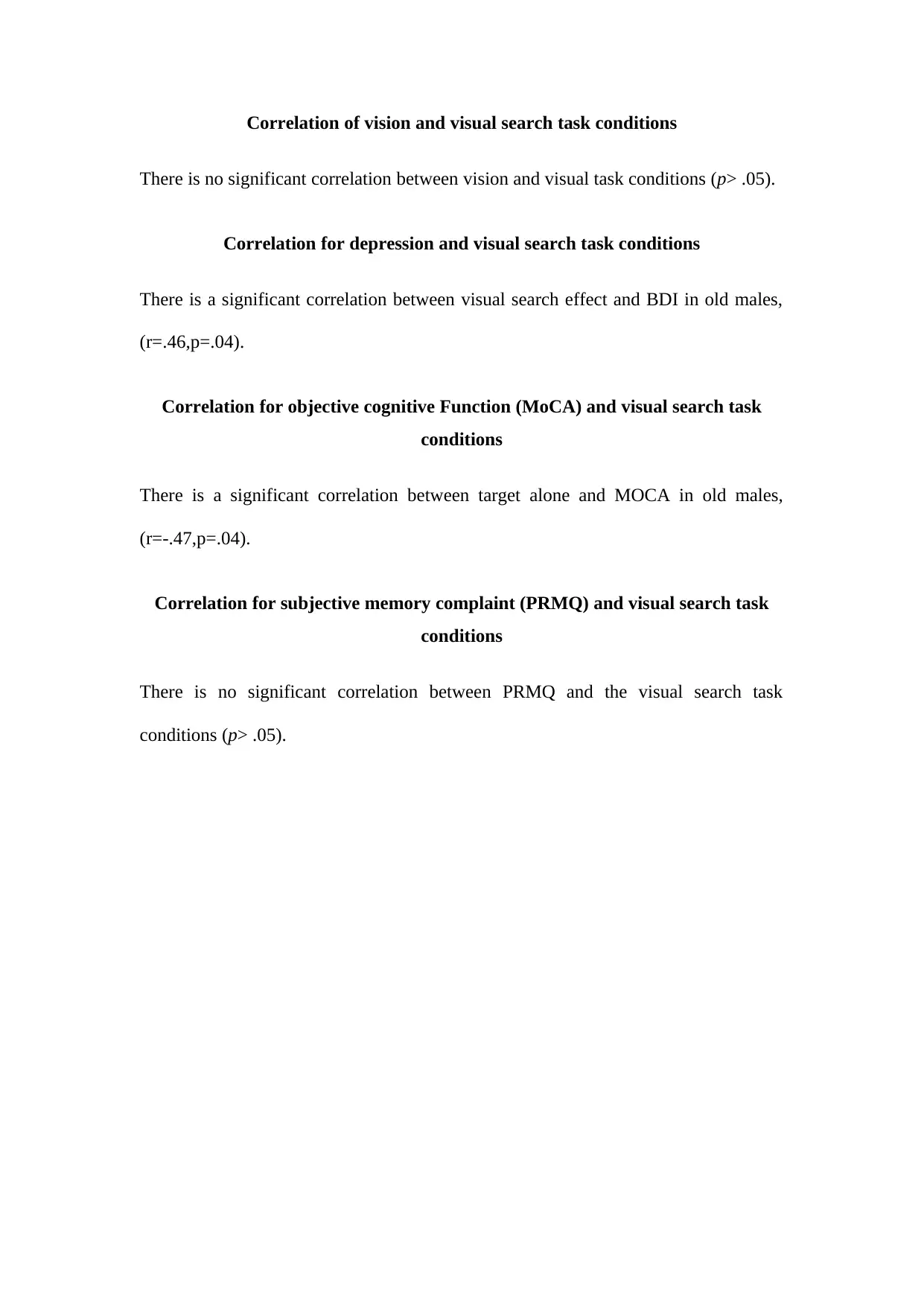
Correlation of vision and visual search task conditions
There is no significant correlation between vision and visual task conditions (p> .05).
Correlation for depression and visual search task conditions
There is a significant correlation between visual search effect and BDI in old males,
(r=.46,p=.04).
Correlation for objective cognitive Function (MoCA) and visual search task
conditions
There is a significant correlation between target alone and MOCA in old males,
(r=-.47,p=.04).
Correlation for subjective memory complaint (PRMQ) and visual search task
conditions
There is no significant correlation between PRMQ and the visual search task
conditions (p> .05).
There is no significant correlation between vision and visual task conditions (p> .05).
Correlation for depression and visual search task conditions
There is a significant correlation between visual search effect and BDI in old males,
(r=.46,p=.04).
Correlation for objective cognitive Function (MoCA) and visual search task
conditions
There is a significant correlation between target alone and MOCA in old males,
(r=-.47,p=.04).
Correlation for subjective memory complaint (PRMQ) and visual search task
conditions
There is no significant correlation between PRMQ and the visual search task
conditions (p> .05).
Paraphrase This Document
Need a fresh take? Get an instant paraphrase of this document with our AI Paraphraser
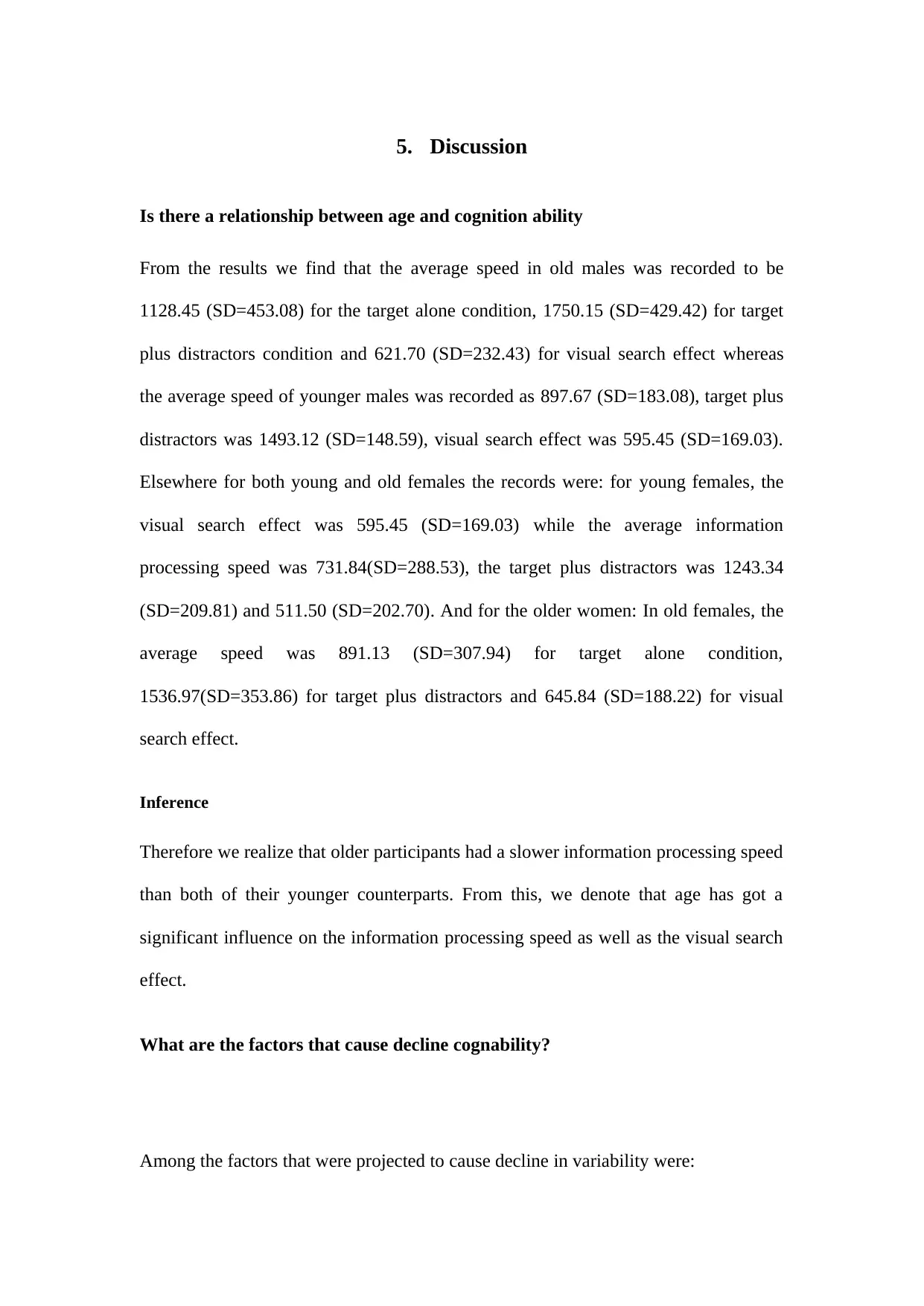
5. Discussion
Is there a relationship between age and cognition ability
From the results we find that the average speed in old males was recorded to be
1128.45 (SD=453.08) for the target alone condition, 1750.15 (SD=429.42) for target
plus distractors condition and 621.70 (SD=232.43) for visual search effect whereas
the average speed of younger males was recorded as 897.67 (SD=183.08), target plus
distractors was 1493.12 (SD=148.59), visual search effect was 595.45 (SD=169.03).
Elsewhere for both young and old females the records were: for young females, the
visual search effect was 595.45 (SD=169.03) while the average information
processing speed was 731.84(SD=288.53), the target plus distractors was 1243.34
(SD=209.81) and 511.50 (SD=202.70). And for the older women: In old females, the
average speed was 891.13 (SD=307.94) for target alone condition,
1536.97(SD=353.86) for target plus distractors and 645.84 (SD=188.22) for visual
search effect.
Inference
Therefore we realize that older participants had a slower information processing speed
than both of their younger counterparts. From this, we denote that age has got a
significant influence on the information processing speed as well as the visual search
effect.
What are the factors that cause decline cognability?
Among the factors that were projected to cause decline in variability were:
Is there a relationship between age and cognition ability
From the results we find that the average speed in old males was recorded to be
1128.45 (SD=453.08) for the target alone condition, 1750.15 (SD=429.42) for target
plus distractors condition and 621.70 (SD=232.43) for visual search effect whereas
the average speed of younger males was recorded as 897.67 (SD=183.08), target plus
distractors was 1493.12 (SD=148.59), visual search effect was 595.45 (SD=169.03).
Elsewhere for both young and old females the records were: for young females, the
visual search effect was 595.45 (SD=169.03) while the average information
processing speed was 731.84(SD=288.53), the target plus distractors was 1243.34
(SD=209.81) and 511.50 (SD=202.70). And for the older women: In old females, the
average speed was 891.13 (SD=307.94) for target alone condition,
1536.97(SD=353.86) for target plus distractors and 645.84 (SD=188.22) for visual
search effect.
Inference
Therefore we realize that older participants had a slower information processing speed
than both of their younger counterparts. From this, we denote that age has got a
significant influence on the information processing speed as well as the visual search
effect.
What are the factors that cause decline cognability?
Among the factors that were projected to cause decline in variability were:
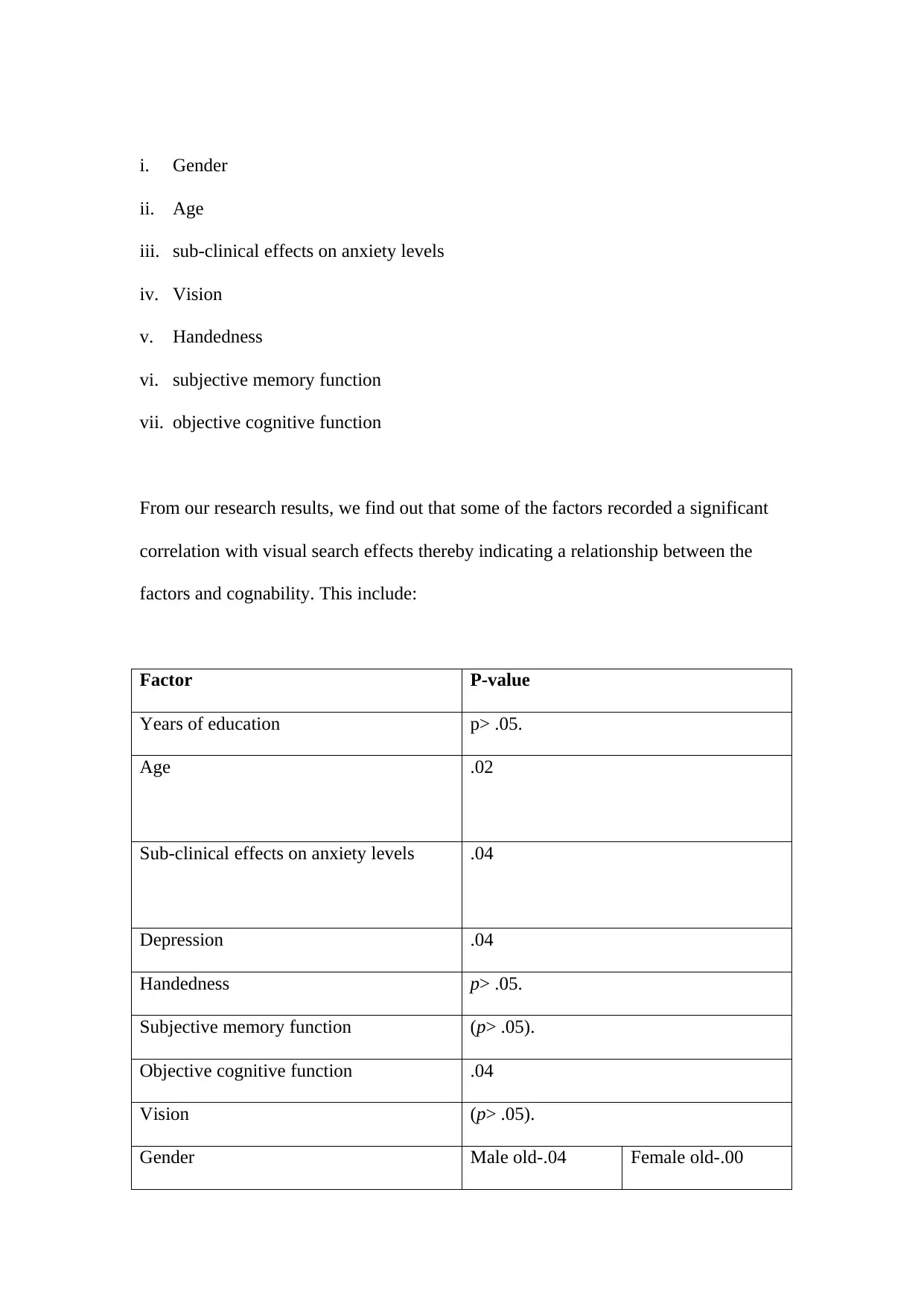
i. Gender
ii. Age
iii. sub-clinical effects on anxiety levels
iv. Vision
v. Handedness
vi. subjective memory function
vii. objective cognitive function
From our research results, we find out that some of the factors recorded a significant
correlation with visual search effects thereby indicating a relationship between the
factors and cognability. This include:
Factor P-value
Years of education p> .05.
Age .02
Sub-clinical effects on anxiety levels .04
Depression .04
Handedness p> .05.
Subjective memory function (p> .05).
Objective cognitive function .04
Vision (p> .05).
Gender Male old-.04 Female old-.00
ii. Age
iii. sub-clinical effects on anxiety levels
iv. Vision
v. Handedness
vi. subjective memory function
vii. objective cognitive function
From our research results, we find out that some of the factors recorded a significant
correlation with visual search effects thereby indicating a relationship between the
factors and cognability. This include:
Factor P-value
Years of education p> .05.
Age .02
Sub-clinical effects on anxiety levels .04
Depression .04
Handedness p> .05.
Subjective memory function (p> .05).
Objective cognitive function .04
Vision (p> .05).
Gender Male old-.04 Female old-.00
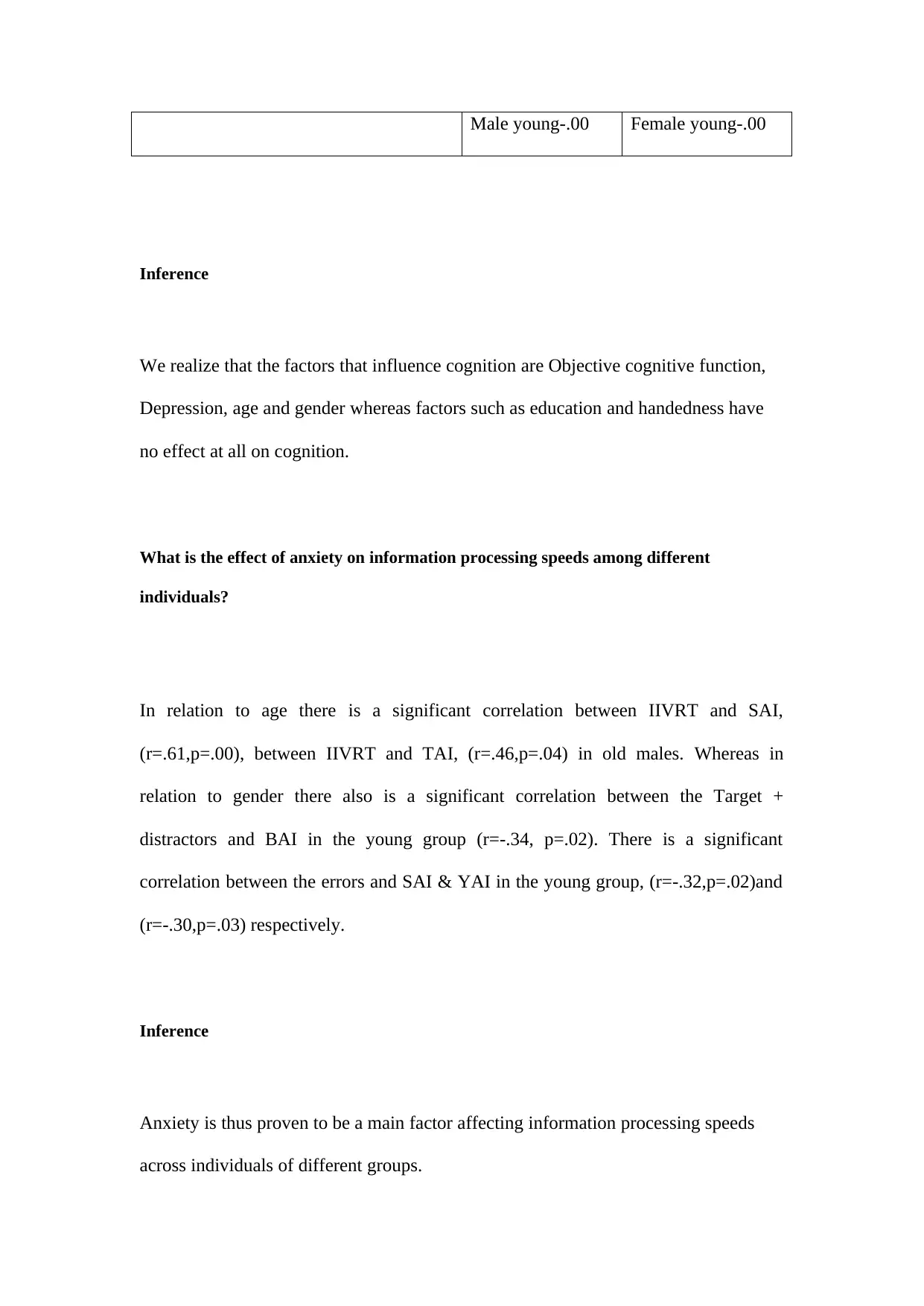
Male young-.00 Female young-.00
Inference
We realize that the factors that influence cognition are Objective cognitive function,
Depression, age and gender whereas factors such as education and handedness have
no effect at all on cognition.
What is the effect of anxiety on information processing speeds among different
individuals?
In relation to age there is a significant correlation between IIVRT and SAI,
(r=.61,p=.00), between IIVRT and TAI, (r=.46,p=.04) in old males. Whereas in
relation to gender there also is a significant correlation between the Target +
distractors and BAI in the young group (r=-.34, p=.02). There is a significant
correlation between the errors and SAI & YAI in the young group, (r=-.32,p=.02)and
(r=-.30,p=.03) respectively.
Inference
Anxiety is thus proven to be a main factor affecting information processing speeds
across individuals of different groups.
Inference
We realize that the factors that influence cognition are Objective cognitive function,
Depression, age and gender whereas factors such as education and handedness have
no effect at all on cognition.
What is the effect of anxiety on information processing speeds among different
individuals?
In relation to age there is a significant correlation between IIVRT and SAI,
(r=.61,p=.00), between IIVRT and TAI, (r=.46,p=.04) in old males. Whereas in
relation to gender there also is a significant correlation between the Target +
distractors and BAI in the young group (r=-.34, p=.02). There is a significant
correlation between the errors and SAI & YAI in the young group, (r=-.32,p=.02)and
(r=-.30,p=.03) respectively.
Inference
Anxiety is thus proven to be a main factor affecting information processing speeds
across individuals of different groups.
Secure Best Marks with AI Grader
Need help grading? Try our AI Grader for instant feedback on your assignments.
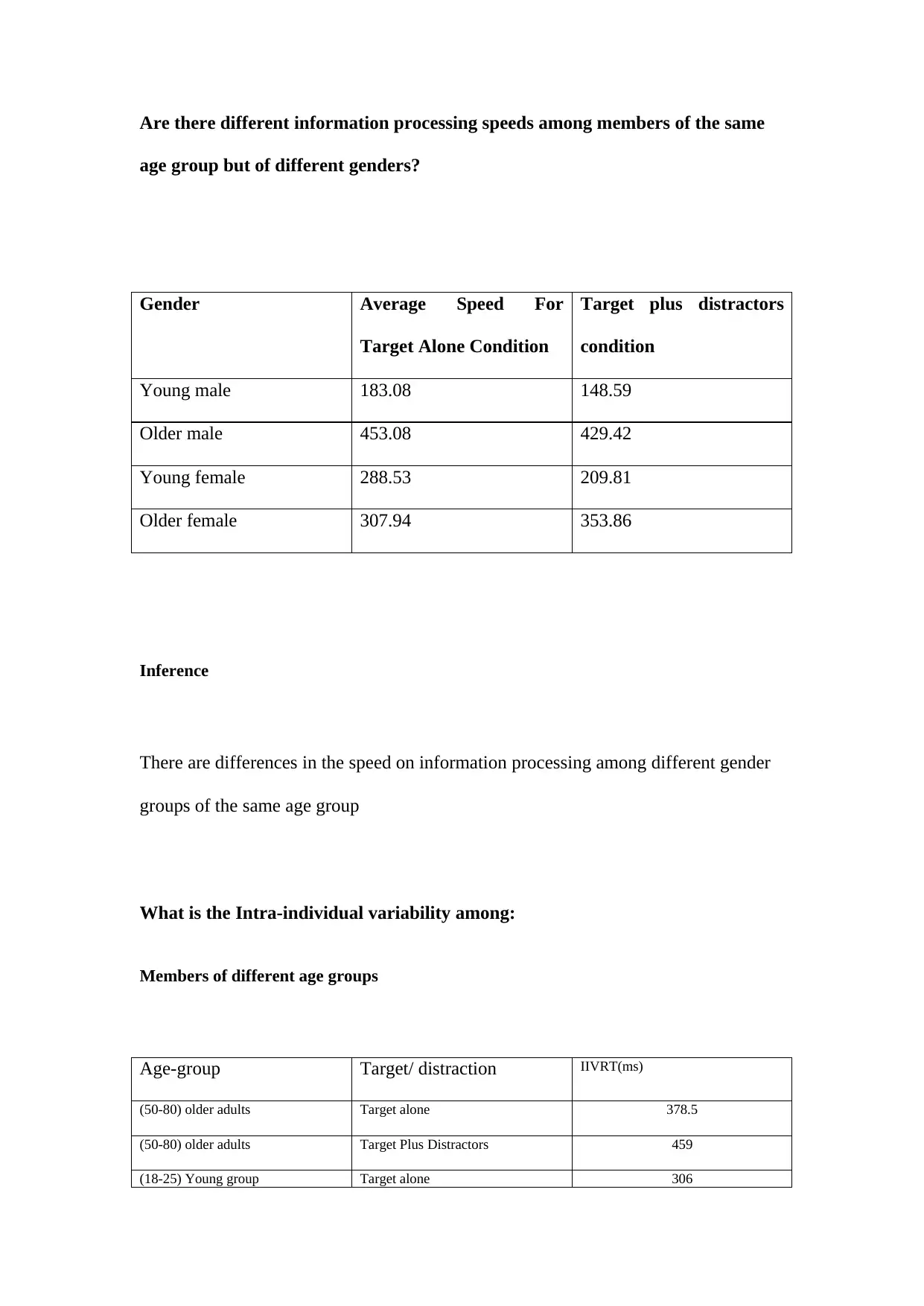
Are there different information processing speeds among members of the same
age group but of different genders?
Gender Average Speed For
Target Alone Condition
Target plus distractors
condition
Young male 183.08 148.59
Older male 453.08 429.42
Young female 288.53 209.81
Older female 307.94 353.86
Inference
There are differences in the speed on information processing among different gender
groups of the same age group
What is the Intra-individual variability among:
Members of different age groups
Age-group Target/ distraction IIVRT(ms)
(50-80) older adults Target alone 378.5
(50-80) older adults Target Plus Distractors 459
(18-25) Young group Target alone 306
age group but of different genders?
Gender Average Speed For
Target Alone Condition
Target plus distractors
condition
Young male 183.08 148.59
Older male 453.08 429.42
Young female 288.53 209.81
Older female 307.94 353.86
Inference
There are differences in the speed on information processing among different gender
groups of the same age group
What is the Intra-individual variability among:
Members of different age groups
Age-group Target/ distraction IIVRT(ms)
(50-80) older adults Target alone 378.5
(50-80) older adults Target Plus Distractors 459
(18-25) Young group Target alone 306
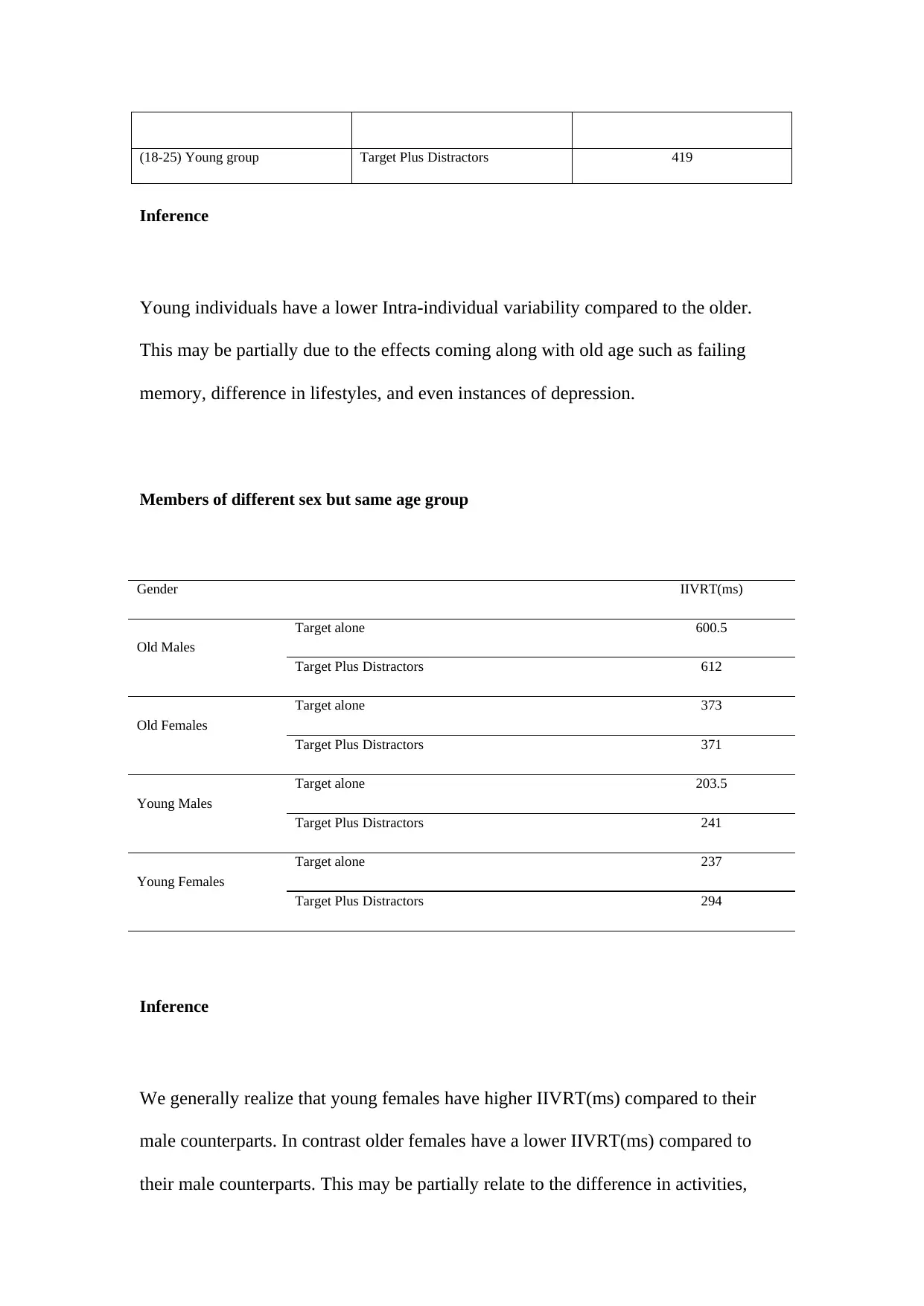
(18-25) Young group Target Plus Distractors 419
Inference
Young individuals have a lower Intra-individual variability compared to the older.
This may be partially due to the effects coming along with old age such as failing
memory, difference in lifestyles, and even instances of depression.
Members of different sex but same age group
Gender IIVRT(ms)
Old Males
Target alone 600.5
Target Plus Distractors 612
Old Females
Target alone 373
Target Plus Distractors 371
Young Males
Target alone 203.5
Target Plus Distractors 241
Young Females
Target alone 237
Target Plus Distractors 294
Inference
We generally realize that young females have higher IIVRT(ms) compared to their
male counterparts. In contrast older females have a lower IIVRT(ms) compared to
their male counterparts. This may be partially relate to the difference in activities,
Inference
Young individuals have a lower Intra-individual variability compared to the older.
This may be partially due to the effects coming along with old age such as failing
memory, difference in lifestyles, and even instances of depression.
Members of different sex but same age group
Gender IIVRT(ms)
Old Males
Target alone 600.5
Target Plus Distractors 612
Old Females
Target alone 373
Target Plus Distractors 371
Young Males
Target alone 203.5
Target Plus Distractors 241
Young Females
Target alone 237
Target Plus Distractors 294
Inference
We generally realize that young females have higher IIVRT(ms) compared to their
male counterparts. In contrast older females have a lower IIVRT(ms) compared to
their male counterparts. This may be partially relate to the difference in activities,

(Fougnie, 2008) that both genders engage which may in the long run to old age
influence the IIVRT(ms). The activities may include the kind of carrier paths the male
and female choose which most often differ. Therefore we note that as people grow up,
the rate of IIV is not constant i.e. it is prone to change given a wide range of factors
such as those we discussed before. I.e. anxiety inducers e.t.c
influence the IIVRT(ms). The activities may include the kind of carrier paths the male
and female choose which most often differ. Therefore we note that as people grow up,
the rate of IIV is not constant i.e. it is prone to change given a wide range of factors
such as those we discussed before. I.e. anxiety inducers e.t.c
Paraphrase This Document
Need a fresh take? Get an instant paraphrase of this document with our AI Paraphraser
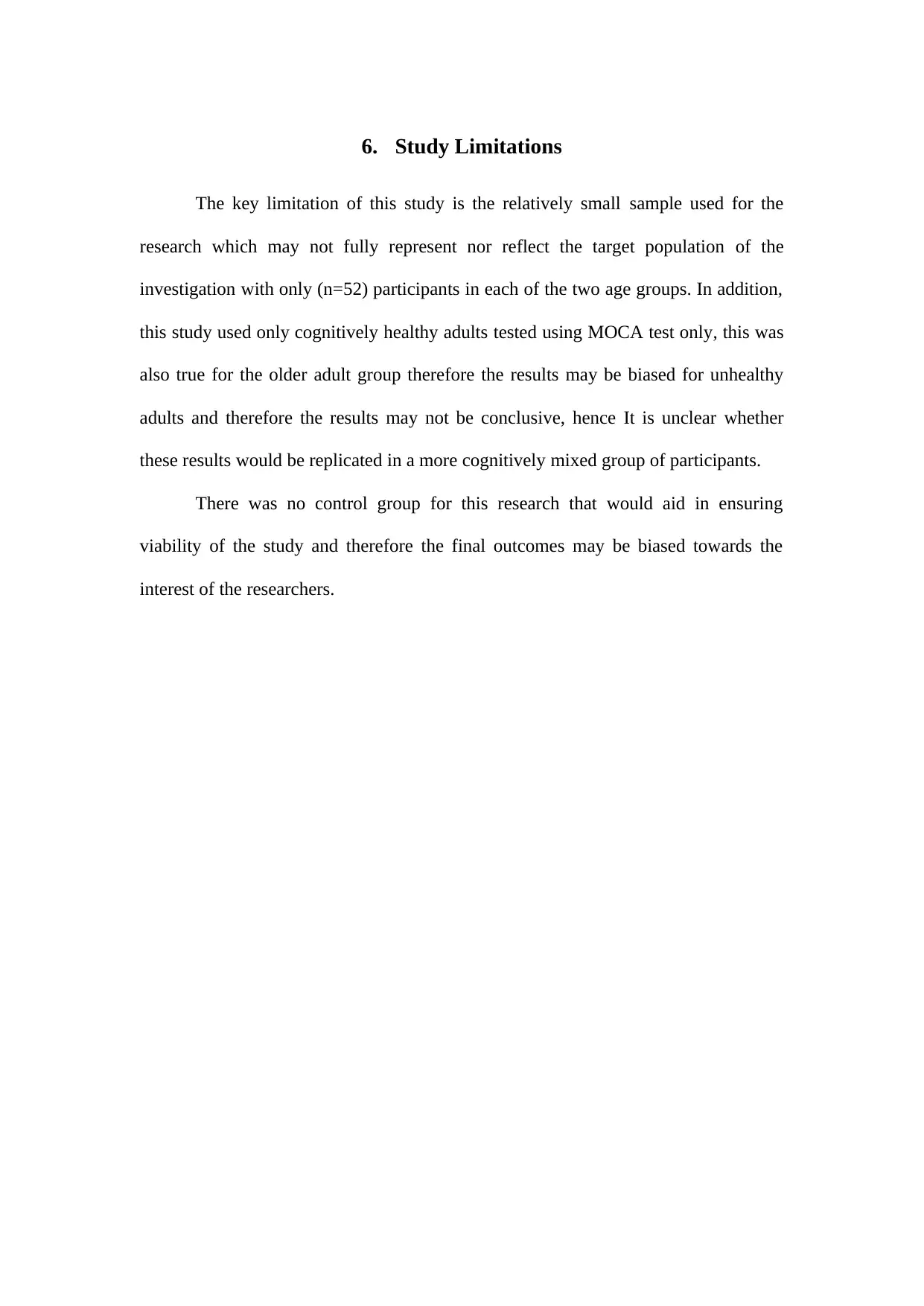
6. Study Limitations
The key limitation of this study is the relatively small sample used for the
research which may not fully represent nor reflect the target population of the
investigation with only (n=52) participants in each of the two age groups. In addition,
this study used only cognitively healthy adults tested using MOCA test only, this was
also true for the older adult group therefore the results may be biased for unhealthy
adults and therefore the results may not be conclusive, hence It is unclear whether
these results would be replicated in a more cognitively mixed group of participants.
There was no control group for this research that would aid in ensuring
viability of the study and therefore the final outcomes may be biased towards the
interest of the researchers.
The key limitation of this study is the relatively small sample used for the
research which may not fully represent nor reflect the target population of the
investigation with only (n=52) participants in each of the two age groups. In addition,
this study used only cognitively healthy adults tested using MOCA test only, this was
also true for the older adult group therefore the results may be biased for unhealthy
adults and therefore the results may not be conclusive, hence It is unclear whether
these results would be replicated in a more cognitively mixed group of participants.
There was no control group for this research that would aid in ensuring
viability of the study and therefore the final outcomes may be biased towards the
interest of the researchers.
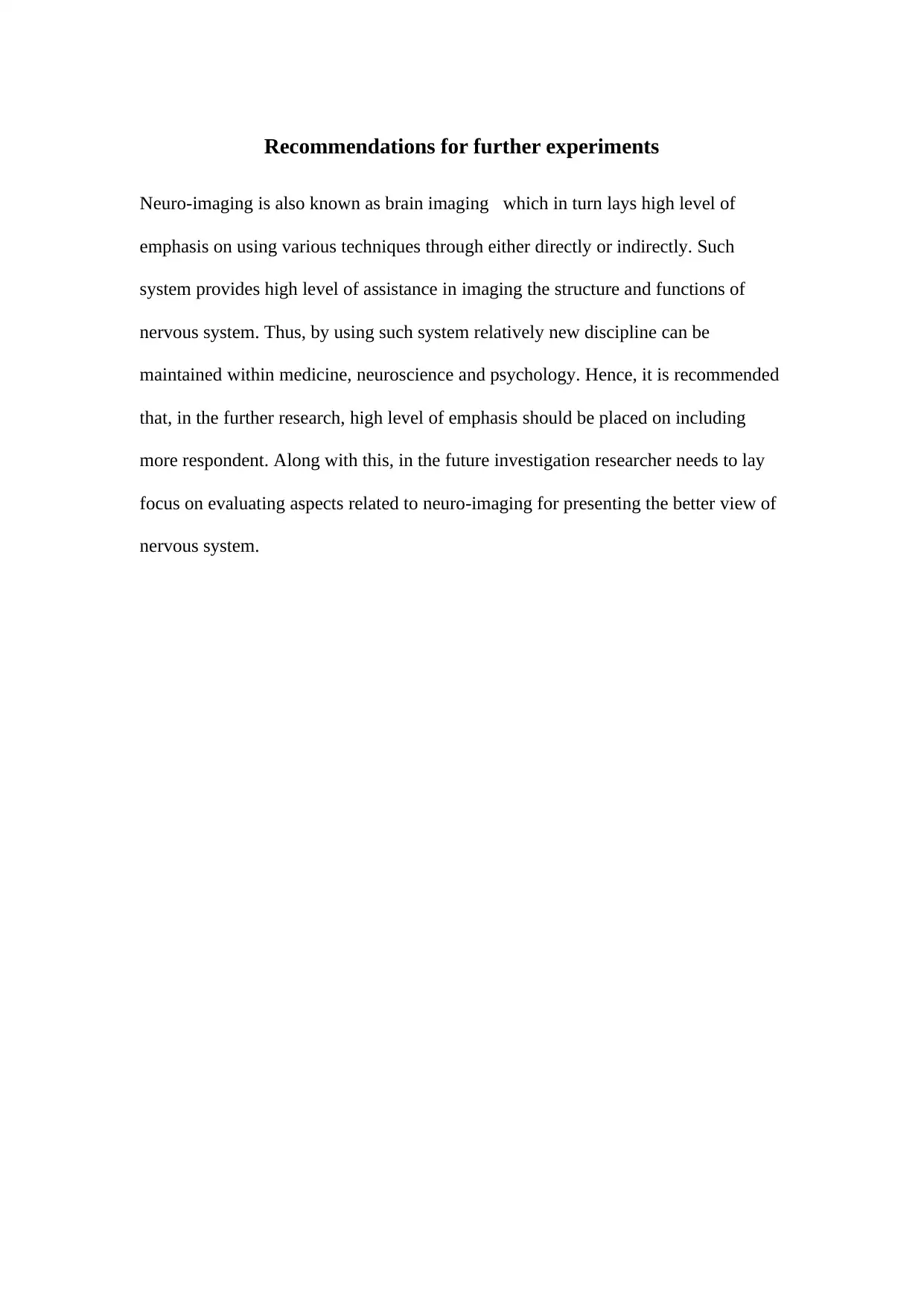
Recommendations for further experiments
Neuro-imaging is also known as brain imaging which in turn lays high level of
emphasis on using various techniques through either directly or indirectly. Such
system provides high level of assistance in imaging the structure and functions of
nervous system. Thus, by using such system relatively new discipline can be
maintained within medicine, neuroscience and psychology. Hence, it is recommended
that, in the further research, high level of emphasis should be placed on including
more respondent. Along with this, in the future investigation researcher needs to lay
focus on evaluating aspects related to neuro-imaging for presenting the better view of
nervous system.
Neuro-imaging is also known as brain imaging which in turn lays high level of
emphasis on using various techniques through either directly or indirectly. Such
system provides high level of assistance in imaging the structure and functions of
nervous system. Thus, by using such system relatively new discipline can be
maintained within medicine, neuroscience and psychology. Hence, it is recommended
that, in the further research, high level of emphasis should be placed on including
more respondent. Along with this, in the future investigation researcher needs to lay
focus on evaluating aspects related to neuro-imaging for presenting the better view of
nervous system.
1 out of 39
Related Documents
Your All-in-One AI-Powered Toolkit for Academic Success.
+13062052269
info@desklib.com
Available 24*7 on WhatsApp / Email
![[object Object]](/_next/static/media/star-bottom.7253800d.svg)
Unlock your academic potential
© 2024 | Zucol Services PVT LTD | All rights reserved.





